Abstract
Electric vehicles (EVs) have seen significant growth due to the increasing awareness about environmental concerns and the negative impacts of internal combustion engine vehicles (ICEVs). The electric vehicle landscape is rapidly evolving, with EV policies, battery, and charging infrastructure and electric vehicle-to-everything (V2X) at its forefront. This review study used a bibliometric analysis of the Scopus database to investigate the development of EV technology. This bibliometric study specifically focuses on analyzing electric vehicle trends, policy implications, lithium-ion batteries, EV battery management systems, charging infrastructure, EV smart charging technologies, and V2X. Through this detailed bibliometric analysis discussion, we aim to provide a better understanding of holistic EV technology and inspire further research in electric vehicles. The analysis covers the period from 1990 to 2022. This bibliometric analysis underscores the interplay of electric vehicle policies, technology, and infrastructure, specifically focusing on developments in battery management and the possibility of V2X technology. In addition, this bibliometric analysis suggests the synchronization of international electric vehicle policy, advancement of battery technology, and promotion of the use of EV smart charging and V2X systems. This bibliometric analysis emphasizes that the expansion of EVs and sustainable mobility relies on a comprehensive strategy that encompasses policy, technology, and infrastructure. This bibliometric analysis recommends fostering collaboration between different sectors to drive innovation and advancements in electric vehicle technology.
1. Introduction: Electric Vehicle and Bibliometric Analysis
1.1. Electric Vehicles: Sustainability, Technology, and Policy Impacts
In the sustainable transportation concept (Figure 1), the subject of electric vehicles (EVs) with their opportunities and challenges has become one of the most prominent issues [,]. Several key factors have influenced significant changes in the global outlook on mobility []. One very important factor is the increasing awareness about environmental concerns and the negative impacts of conventional or internal combustion engine vehicles (ICEVs) that operate on fossil fuels [,,]. Internal combustion engine is a significant source of air pollution that degrades the air quality in cities all over the world and carbon emissions that contribute to climate change [,]. There is a growing urgency to implement sustainable technologies and lessen the transportation sector’s environmental impact. Meanwhile, the adoption of EVs has also been significantly influenced by economic benefits, such as lower long-term operating and fuel expenses [,].
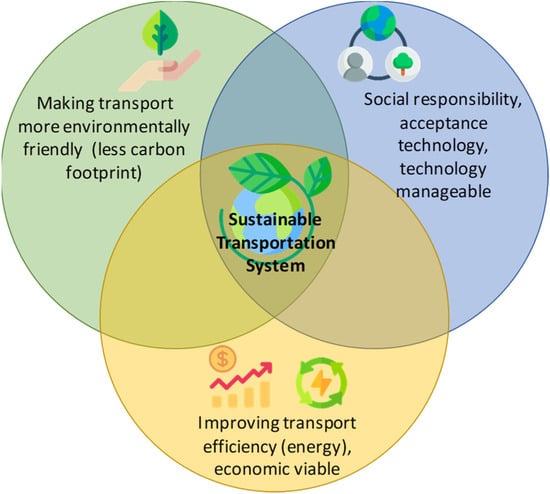
Figure 1.
Sustainable concept by incorporating the environmental, social, and economic pillars (adapted from Makarova et al. []).
Along with this awareness, there have been notable technological advancements in electric motors and batteries that have made it possible to produce EVs with greater range and efficiency [,]. Moreover, the development of more advanced and efficient battery technologies has allowed EVs to have longer ranges of battery life, making them more attractive to EV’s consumers []. Battery management is an important focus, ensuring that vehicle batteries work optimally and have a long service life []. EV charging infrastructure continues to evolve to make it easier for vehicle owners to charge their vehicles in various locations. Smart charging integrates smart technology to optimize charging based on fluctuating energy demand and tariffs, which can reduce charging costs []. The technology has prompted major automotive manufacturers to invest in their own EV research and development.
Support from governments around the world in the form of policies and incentives that stimulate the adoption of EVs has also played an important role in the growth of this trend [,]. Tax incentives, reduced licensing fees, and building better charging infrastructure are some initiatives or steps that have been taken to encourage consumers and vehicle manufacturers to adopt electric technology [,,]. Recent trends in the EV industry include several important aspects that contribute to the technological development and adoption of EVs. Policy plays a key role in driving the growth of EVs with various incentives, regulations, and emission reduction targets set by governments in various countries [,,]. With these various factors, the trend of EVs is increasing and is expected to continue to grow in the future.
Another innovative solution for EVs has grown. Vehicle-to-everything (V2X), as shown in Figure 2, is an advanced trend that connects EVs with their surroundings [,]. These include vehicle-to-grid (V2G) [,] which allows vehicles to contribute back to the power grid electricity when it is not in operation mode, as well as vehicle-to-home (V2H) [,] and vehicle-to-load (V2L) [,] which allow vehicles to charge or provide power to homes or other devices. Vehicle-to-vehicle (V2V) networks refer to mobile nodes that consist exclusively of moving vehicles communicating with one another. Vehicle-to-infrastructure (V2I) or vehicle-to-pedestrian (V2P) networks are created when mobile vehicles engage with either roadside infrastructure or pedestrians [,]. When a vehicle connects with IT networks and/or data centers, the network type is referred to as vehicle-to-network (V2N) [,]. With all of this, the technology for electric mobility becomes more sustainable and integrated. These trends reflect a shift towards future sustainability, energy efficiency, and intelligent connectivity.
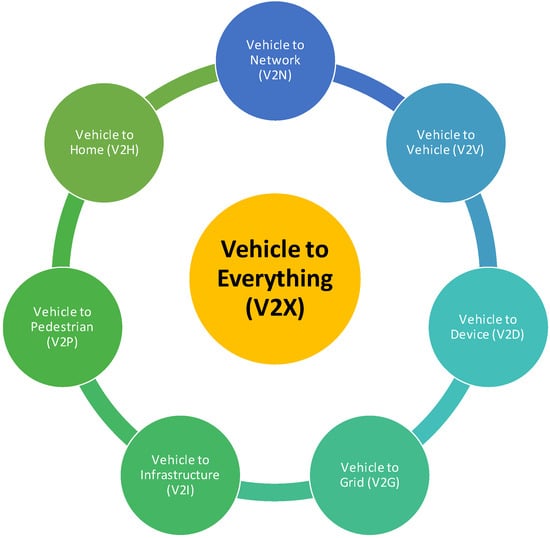
Figure 2.
Various vehicle-to-everything (V2X) technology.
1.2. Research Objective: Bibliometric Analysis of Trends in Electric Vehicles
This study reviews the most recent advancements in EV research and their trends using bibliometric analysis. The bibliometric is a fascinating subject that offers quantitative and objective insights into research trends, the patterns of scientific growth, and the influence of scholarly works in a given field, such as business, engineering, medicine, and policymaking [,,,]. Bibliometric studies help researchers, institutions, and policymakers identify urgent research areas, measure the impact of scholarly work, and comprehend the contributions of individuals, institutions, or nations in a knowledge domain through meticulous quantitative analysis of the quantity of publications, citations, and collaborations among researchers []. In addition, bibliometrics can also be used as a tool to plan future research strategies, highlighting possible directions and trends in scientific developments []. Although it can measure the impact and frequency of citations to a publication, it is not always able to capture the exact context or relevance of those citations. However, the limitation of providing a comprehensive picture of the true quality of a scientific work shall be discovered in the content analysis.
1.3. Research Methodology
We present a practical methodology that outlines the steps involved in bibliometric analysis. Öztürk et al. [] proposed an applicable framework for the steps which should be found in bibliometric research. Figure 3 shows the methodological outline of this article. This study employs a comprehensive bibliometric analysis of the Scopus database to investigate several keywords in the development of EV technology. The input phase involves selecting Scopus for its extensive coverage and reliability, followed by a strategic search using selected keywords [,]. The search criteria include filtering for relevant publications. The processing phase utilizes tools like VOSviewer version 1.6.20 to perform citation analysis, co-citation analysis, co-authorship analysis, and keyword co-occurrence analysis. These methods identify trends, key contributors, and research networks, while thematic analysis groups related papers into key themes using clustering techniques.
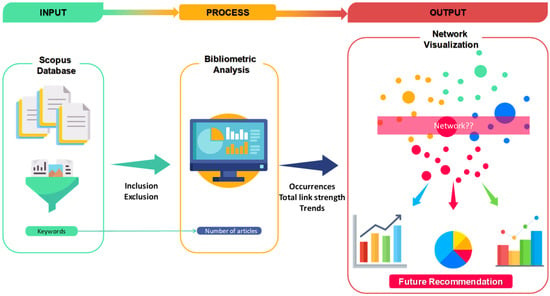
Figure 3.
Methodological outline of paper.
The output of this bibliometric analysis reveals significant findings, including key trends in EV research, influential authors, and important publications. Visualizations such as citation maps and network diagrams help interpret the data, highlighting developments in policy implications, lithium-ion batteries, and V2X technologies. This study also proposes future research directions and offers recommendations to foster innovation and advancement in EV technology.
1.4. Novelty of the Study: Electric Vehicles and Bibliometric Analysis
Various review articles on EV incorporate bibliometric analysis in their studies using the VOSviewer software. The previous studies dominantly reviewed the technological, environmental, economic, and social aspects. Barbosa et al. [] investigated the general term of EV. They examined the most pertinent themes related to EVs with the keyword “electric vehicle”. They presented related information on the key subjects covered in the study, which included EVs and their emerging technologies. In the specific aspect of EVs, Miah et al. [] evaluated the energy management scheme (EMS) in EVs. They investigated optimized EMSs for EV applications. Raboaca et al. [] performed a classic analysis of the management strategies to recognize the main research directions for designing an optimal strategy.
As a main part of EVs, the thermal performance of a battery pack has a significant influence on its durability, aging, and stability. Murugan et al. [] investigated lithium-ion batteries (LIBs) using bibliometric analysis. They reviewed the thermal management system (TMS) of battery packs as one of the important research areas in EVs.
In regard to the economic aspect, Ayodele and Mustapa [] examined life cycle cost analysis (LCCA) articles on EVs. The LCC variation in the various EVs was found to be dependent on a number of variables. Secinaro et al. [] demonstrated the business model choices for charging technologies, driver services, electricity management, commercial contracts, and plants. Soares et al. [] analyzed the state-of-the-art EV supply chain to identify trends for further studies and to find critical points.
In the social aspect, a thorough analysis was provided by Bhat and Verma [], with an emphasis on research from developing economies. They identified and categorized individual characteristics and alternative attributes affecting EV adoption. According to this analysis, the majority of the studies’ most consistent variables were psychological, social, and performance-related. The previous works on EV bibliometric analysis are summarized in Table 1.

Table 1.
Summary of previous works on EV bibliometric analysis.
From Table 1, it is clear that previous bibliometric analysis has not comprehensively discussed electric vehicle trends, policies, EV lithium-ion batteries, battery management systems, EV charging infrastructures, smart charging, and V2X in much detail. These themes were chosen as the main factors of EV growth adoption in the world. Therefore, this article reviews these themes to find out the trend of research.
2. Method: Bibliometric Analysis for Electric Vehicles
Broadus [] defined that bibliometric is the process of analyzing published information, together with their associated metadata, such as abstracts, keywords, and citations. This analysis involves utilizing statistics to describe and establish connections between these published works. Ninkov et al. [] provided several key definitions of bibliometric concepts, such as “Evaluative bibliometrics” and “Relational bibliometrics”. Evaluative bibliometrics are used to describe the characteristics of published information. Relational bibliometrics is a research method where researchers analyze shared metadata occurrences, such as citations, keywords, and authors.
This paper specifically aims to analyze seven different keywords derived from the term “electric vehicle” in the Scopus database. The study was undertaken in the year 2023, and while the majority of publications are still in progress during this period, our reliance is placed on data up until 2022, which have been fully documented. As an illustration, the quantity of articles pertaining to V2X that were indexed in the Scopus database showed a decline from 943 in 2022 to 671 in 2023. This drop can be ascribed to the incomplete or insufficiently recorded data for the year 2023, rather than signifying a declining trend. Therefore, we include studies up to 2022 only.
It is important to acknowledge that there are other elements that can lead to variations in the number of publications. The variability in research output on an annual basis can be attributed to several reasons, including the availability of financial resources, changes in research trends, and occurrences of some unexpected events such as COVID-19, which have the potential to disrupt research activities.
In our analysis, we refrained from implementing any search filters except for the duration (32 years from 1990 to 2022 only). However, our attention was directed towards the top 10–20 outcomes for each keyword, with the aim of offering valuable perspectives on the prevailing research within the domain. The data collection period encompassed the years 1990 to 2022, despite the fact that scholarly investigations on EVs may be traced back as early as 1911.
The results were gathered from the Scopus database with the details shown in Figure 4. The keyword “electric vehicle” yielded a total of 135,388 documents, “EV policy” produced 2038 search results, “EV lithium-ion batteries” generated 3463 documents, “EV battery management systems” led to 3627 scholarly papers, “EV charging infrastructure” yielded 2442 documents, “EV smart charging” generated 2668 articles, and “V2X” resulted in a total of 4164 documents.
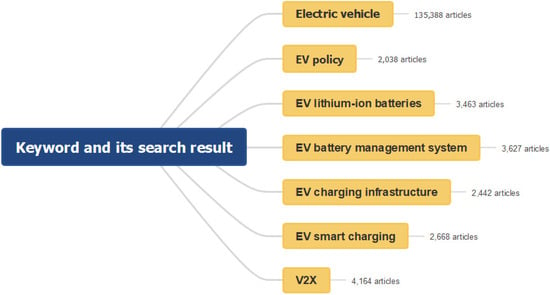
Figure 4.
Keyword and its search results spanning 32 years from 1990 to 2022, ranging from general EV keywords to specific ones found in Scopus database.
To the best of the authors’ knowledge, the selected keywords are crucial in the field of EVs and are important to be analyzed in bibliometric analysis for each keyword. The basic technical keywords in the EV field are electric vehicle, battery, and charging infrastructure which are fundamental in this technology. Then, it is expanded to lithium-ion battery, battery management system, smart charging, and V2X as the development of EV technology. Moreover, keyword policy is an issue in accommodating the adoption of EVs.
“Electric vehicle” represents the overarching concept of EVs, while “EV policy” reflects the regulatory environment and government incentives shaping EV adoption. “EV lithium-ion battery” and “EV battery management system” are critical for improving battery performance, efficiency, and safety, essential for widespread EV adoption. “EV charging infrastructure” research focuses on developing efficient and scalable charging solutions, addressing range anxiety, and supporting the growing number of EVs. “EV smart charging” optimizes charging processes, reducing costs, and minimizing grid impact. “V2X” technology enhances communication capabilities in vehicles, grid stability, supports renewable energy integration, and improves overall transportation efficiency.
In the process of conducting our keyword analysis, we utilized the VOSviewer software, a robust tool specifically developed for construction and visual representation []. VOSviewer was the predominant bibliometric software in terms of usage []. VOSViewer offers a great network visualization and can load and import data from many sources []. These networks might have a range of components, including journals, researchers, or individual publications. They are established based on several characteristics, including citation linkages, bibliographic connections, co-citation patterns, co-authorship partnerships, and keyword associations.
To provide a comprehensive understanding of emerging trends in the field of EV, for this keyword analysis, our investigation was specifically directed towards the examination of the top 100 highly cited papers sourced from the Scopus database. The data were next employed to generate a visual representation in the form of a map, which depicts the frequency and interconnections of keywords. This was accomplished by following the sequential procedure outlined in Figure 5.

Figure 5.
Sequential procedures to execute bibliometric analysis in VOSviewer.
In the process of selecting thresholds, we established a minimum requirement of at least 5 occurrences for each investigated keyword. In the case of the keyword “electric vehicle”, out of 1315 keywords extracted from the top 100 highly cited papers, 58 met this occurrence threshold. For each of these 58 keywords, we calculated the cumulative strength of their co-occurrence links with other keywords, and the keywords with the highest total link strength were chosen. Similarly, for “EV policy”, out of 1421 keywords, 63 met the occurrence threshold, while “EV lithium-ion battery” had 52 out of 1314 keywords meeting the criteria. “EV battery management system” had 73 out of 1223 keywords, “EV charging infrastructure” had 63 out of 1209 keywords, “EV smart charging” had 64 out of 1065 keywords, and “V2X” had 56 out of 1089 keywords that met the established thresholds.
3. Results and Discussion: Electric Vehicles and Bibliometric Analysis
The keyword “electric vehicle” serves as the foundational concept in the study of EVs. It encompasses all types of vehicles that are powered by electric motors and batteries rather than ICEV. Analyzing research papers on EVs provides a comprehensive view of the technological advancements [,,], market trends [,], consumer acceptance [,], and overall impact on the automotive industry and environment [,]. This keyword is crucial for identifying broad trends and major contributions in the field.
The “lithium-ion battery” is a critical component of EVs, affecting their range, performance, cost, and safety. Research on lithium-ion batteries focuses on enhancing energy density, reducing charging times, extending lifespan, and improving safety features [,,,]. This keyword is vital for tracking technological advancements in battery chemistry, manufacturing processes, and recycling methods.
The “battery management system” or BMS is crucial for monitoring and managing the performance and safety of lithium-ion batteries [,]. A BMS ensures optimal battery operation by balancing cell voltages, managing thermal conditions, and preventing overcharging or deep discharging. Research in this area aims to improve the monitoring, protection, charging management, communication, diagnostic, and data management of batteries [].
The “charging infrastructure” is essential for supporting the widespread adoption of EVs. It includes the development of charging stations, fast chargers, and integration with the electrical grid. Research focuses on creating efficient, scalable, and accessible charging solutions to address range anxiety and support the growing number of EVs on the road [,]. Through the analysis of this keyword, it is possible to evaluate the advancements and difficulties in establishing a strong charging infrastructure, identify the top countries and firms in this field, and estimate the influence on the adoption rates of EVs.
“smart charging” refers to technologies and strategies that optimize the charging process to reduce costs, manage energy demand, and minimize the impact on the electrical grid [,]. This includes load balancing, demand response, and time-of-use pricing. Research in smart charging aims to make the charging process more efficient and cost-effective for consumers and utilities [].
The “V2X” technology enables electric vehicles to communicate with the grid, other vehicles, infrastructure, and even homes []. This technology supports grid stability, renewable energy integration, and overall transportation efficiency. Research in this area explores how EVs can act as energy storage units, contribute to grid resilience, and enhance smart city initiatives. V2X research can uncover significant advancements, implementation tactics, and prospective effects on energy and transportation networks or communication.
The “policy” refers to the legislative and regulatory framework that influences the development and adoption of EVs []. Policies include government incentives, subsidies, tax rebates, emissions regulations, and infrastructure development plans [,,]. Exploring EV policy is essential for understanding how different regions and countries are promoting EV adoption, the effectiveness of various policy measures, and how these policies impact market growth and technology development. This keyword influences all aspects of EV development and adoption.
Analyzing these keywords using bibliometric methods provides a holistic view of the EV technology. It helps identify current research trends, technological advancements, policy impacts, and future directions. This comprehensive analysis guides policymakers, researchers, and industry stakeholders in making informed decisions to accelerate the transition to sustainable transportation and address the challenges associated with EV adoption. The correlation among the seven keywords is depicted in Figure 6.

Figure 6.
Illustrative graphic that visually represents the correlation among the seven keywords.
As shown in Figure 6, “electric vehicle” indicates its core role, and arrows show the direct influence and interdependence among the keywords. “Lithium-ion battery” and “battery management system” are closely related, as BMS is crucial for battery performance. “Charging infrastructure” is essential for practical EV use, supported by “smart charging” for efficiency, and “V2X” represents the integration of EVs into broader energy and communication networks, influenced by advancements in charging and battery technologies. “Policy” influences all aspects of EV development and adoption.
3.1. Electric Vehicle Trend: Bibliometric Analysis Results
Electric vehicle research has witnessed exponential growth, with a significant surge in publications in recent years, peaking at 16,434 documents found in the Scopus database in 2022 (Figure 7). This upsurge indicates the accelerating pace of innovation and research in the field of EVs, aligning with the global push for sustainable transportation solutions. The consistent increase in research output from 2010 onwards demonstrates the growing importance of EVs in the transition to eco-friendly mobility to address environmental challenges and reshape the automotive industry on a global scale.
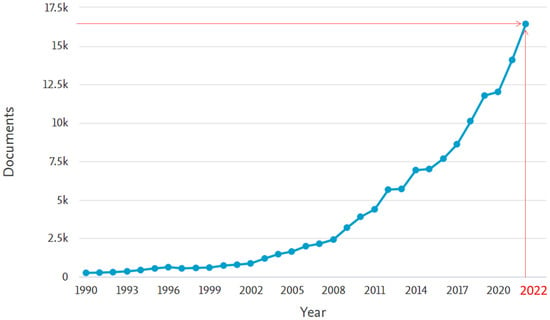
Figure 7.
Electric vehicle papers by year.
Electric vehicle research spans various subject areas, with the majority of documents falling within engineering (101,128 documents) as shown in Figure 8. This indicates the multidisciplinary nature of EV technology and its integration into diverse engineering applications. Apart from the engineering domain, the energy sector is also another area for EV research. Energy (42,742) research plays a critical role in advancing EVs’ sustainable energy sources and systems, while computer science (31,730) reflects the computational aspects of EV technology, including data analytics and optimization. Mathematics (20,093) contributes to modeling and simulation, supporting EV design and performance prediction. Furthermore, environmental science (14,549) underscores the broader sustainability implications of EV adoption, while materials science (11,786) is essential for developing advanced materials for batteries and vehicle components. The results above highlight the interdisciplinary significance of EVs in reshaping transportation, energy systems, and environmental sustainability, fostering innovation across a wide range of academic disciplines and industries.
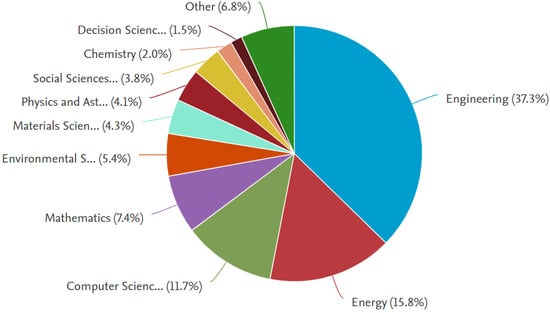
Figure 8.
Electric vehicle papers by subject area.
Electric vehicle research is predominantly published as conference papers (66,903 documents) and articles (58,301) followed by reviews (3896) and book chapters (2369) as illustrated in Figure 9. Furthermore, conference reviews (2212) provide insights into recent EV developments, while notes (611), Short Surveys (388), books (316), and Editorials (131) offer supplementary perspectives. The presence of Errata (88) and Retracted articles (64) emphasizes the quality control and integrity of EV research. These diverse document types indicate the relevance of EV technology across various scientific publications.

Figure 9.
Electric vehicle papers by type.
Electric vehicle research is disseminated across various sources (Figure 10), with SAE Technical Papers (4710 documents) being a significant outlet. Energies (2503) also actively publishes research related to EVs. Additionally, the Journal of Power Sources (1358) and Applied Energy (1187) contribute to the academic and scientific discourse followed by IEEE Access (1173). These results highlight the diverse publication landscape for EV research, with various sources actively contributing to its advancement.
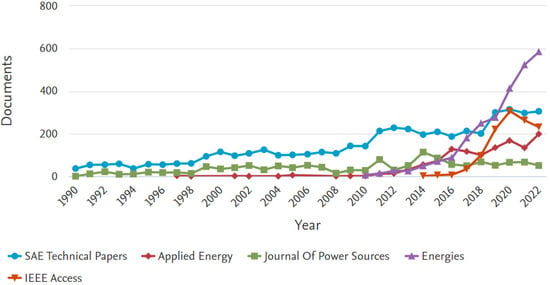
Figure 10.
Electric vehicle papers by source.
Electric vehicle research shows global interest as depicted in Figure 11, with China (35,601 documents) leading in terms of research output. The United States (23,858) closely follows. India (9431) demonstrates growing interest in EVs to address urban mobility and environmental challenges. Germany (8936), Japan (6738), and the United Kingdom (6519) play pivotal roles in shaping EV technology in Europe and Asia. South Korea (5454), Italy (5064), Canada (4514), and France (4125) also contribute significantly to the global landscape, highlighting the collaborative and multidimensional nature of EV research. These results indicate the international focus on EVs, which are considered a transformative solution for reducing emissions and promoting eco-friendly transportation worldwide.
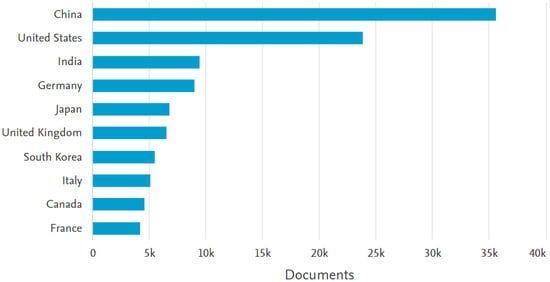
Figure 11.
Electric vehicle papers by country.
Institutional engagement in EV research can be seen in Figure 12, with affiliations such as the Beijing Institute of Technology (2532 documents) and Tsinghua University (2369) taking the lead, underscoring China’s prominent role in advancing EV technology. Tongji University (1382), the Ministry of Education of the People’s Republic of China (1332), and Jilin University (1308) are actively contributing to research and development. The involvement of prestigious institutions such as the Chinese Academy of Sciences (1262), Shanghai Jiao Tong University (1131), and the Harbin Institute of Technology (1093) further highlights China’s leadership in EV innovation. Chongqing University (1087) and Southeast University (945) also play vital roles, emphasizing the global significance of Chinese institutions in shaping the future of electric mobility.
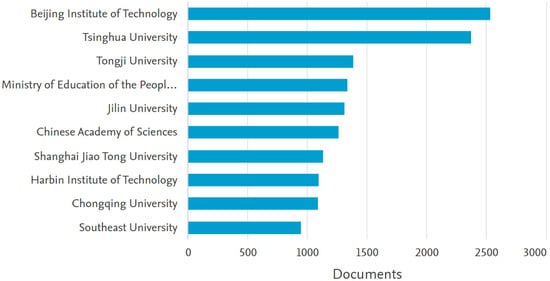
Figure 12.
Electric vehicle papers by affiliation.
Electric vehicle research enjoys substantial funding as shown in Figure 13, with the National Natural Science Foundation of China (9897 documents) taking the lead, reflecting China’s commitment to advancing EV technology. The National Key Research and Development Program of China (1668) and the National Science Foundation (1641) in the United States are following as the significant contributors. The U.S. Department of Energy (1519) further supports research and development in this area followed by the Fundamental Research Funds for the Central Universities (1463). Initiatives like the Horizon 2020 Framework Programme (1191) and contributions from the National Research Foundation of Korea (1050), the European Commission (1006), and the Engineering and Physical Sciences Research Council (934) in the UK emphasize the global recognition of EVs’ pivotal role in sustainable transportation and the need for substantial financial backing to drive innovation and research efforts.
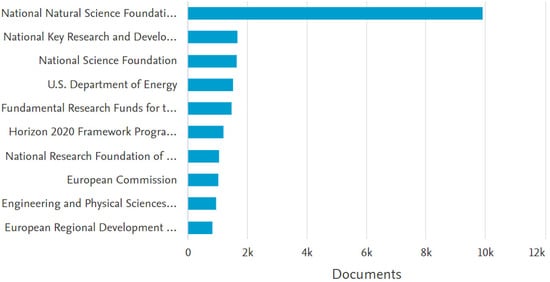
Figure 13.
Electric vehicle papers by funding sponsors.
Figure 14 and Table 2 present an analytical summary of the keywords associated with electric vehicle trends. It specifically highlights the frequency of their occurrences and the total strength of their links in a particular dataset. The term “occurrences” denotes the frequency of each keyword in the dataset, whereas “total link strength” is the measure of the phrase’s significance or connection. The term “electric vehicles” is the most commonly found and highly correlated keyword, suggesting its significant importance in the dataset. Additional significant terms such as “lithium”, “lithium batteries”, and “Secondary batteries” exhibit prominent frequencies and strong connections, underscoring their significance in the realm of electric vehicles. This table comprehensively represents the focus on several components of electric vehicle development, ranging from technical elements such as “Electrodes” and “Electrolytes” to more general ideas like “energy storage” and “electrochemistry”.
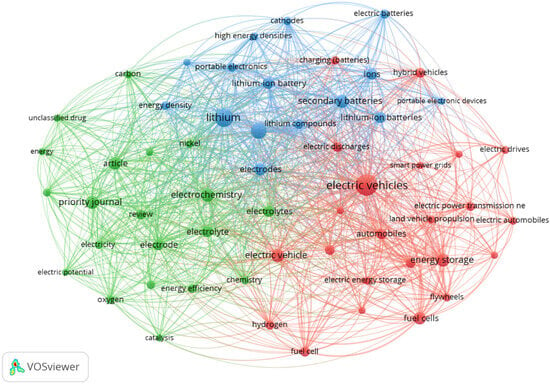
Figure 14.
Network visualization of important keywords for electric vehicle trends.

Table 2.
Occurrences and total link strength for each keyword for electric vehicle trends.
3.2. Electric Vehicle Policy: Bibliometric Analysis Results
Electric vehicle policy research has seen remarkable growth in recent years as shown in Figure 15a, with a substantial increase in publications, peaking at 421 documents in 2022. This surge in interest aligns with the global push for sustainable transportation solutions and the recognition of EVs as a key component of future mobility. The consistent upward trend from 2010 onwards demonstrates the increasing importance of EVs in policy discussions and the transition to cleaner transportation.
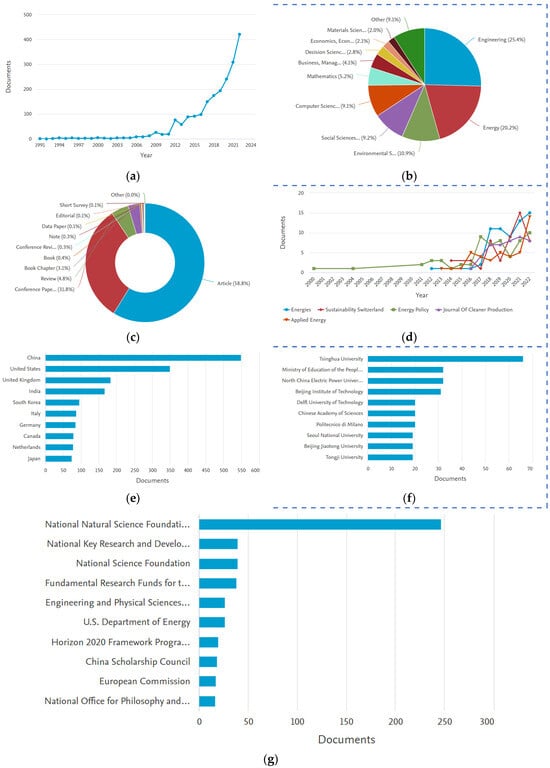
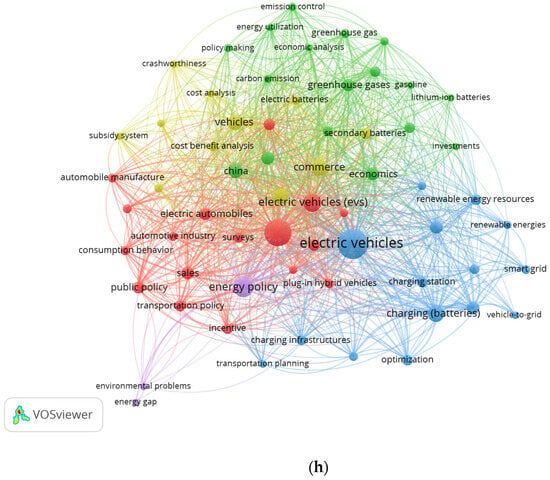
Figure 15.
EV policy papers by year (a), subject area (b), document type (c), source (d), country (e), affiliation (f), funding sponsors (g), and important keywords (h).
Electric vehicle policy research can be found in multiple subject areas (Figure 15b), with engineering (1115 documents) at the forefront, reflecting the technology-driven nature of EV adoption. Energy (888) plays a pivotal role in the policy discourse, as the transition to EVs has profound implications for energy systems. Environmental science (477) also shows the environmental considerations that underpin EV policies, while social sciences (403) explores the societal and behavioral aspects of EV adoption. Computer science (399) and Mathematics (226) contribute computational and analytical insights, facilitating data-driven policy decisions. These results indicate the interdisciplinary nature of EV policy research, thus highlighting the need for holistic approaches that integrate technology, energy, environment, and social dimensions to advance sustainable transportation policies effectively. Figure 15c shows that research on EV policy is primarily published as articles (1199 documents), underlining the scholarly depth and practical significance of this field. Conference papers (648) play a significant role in disseminating findings and facilitating academic discourse, while reviews (97) critically assess policy developments and their impact on EV adoption. Additionally, book chapters (64) and books (8) contribute to the comprehensive knowledge of EV policy, while conference reviews (7) provide insights into recent policy discussions. A small percentage is given by notes (7), Data Papers (3), Editorials (2), Short Surveys (2), and Errata (1). This also underscores the rigorous quality control and multidimensional approach of EV policy research, aiming to inform and guide policy decisions effectively for the sustainable future of transportation.
Electric vehicle policy research is disseminated across various sources as shown in Figure 15d, with Energies (64 documents) and Energy Policy (61) being prominent sources. Sustainability Switzerland (50) showcases the importance of sustainability considerations in EV policy development, while the Journal of Cleaner Production (44) and Applied Energy (43) contribute next, highlighting the multidisciplinary nature of EV policy research. These results illustrate the diverse publication landscape for EV policy research, emphasizing the need for comprehensive and well-informed policy frameworks to accelerate the adoption of EVs and promote sustainable transportation solutions globally.
Research on EV policy is geographically diverse as can be seen in Figure 15e, with China (548 documents) leading in terms of research output, reflecting the nation’s commitment to EV technology and sustainable mobility solutions. The United States (349) actively contributes to policy development, aligning with its role as one of the major players in the automotive industry. The United Kingdom (182) and India (166) demonstrate a growing interest in formulating EV policies to address urban mobility and environmental concerns. South Korea (94), Italy (86), Germany (84), Canada (78), and the Netherlands (77) contribute significantly, reflecting the global importance of EVs and the need for comprehensive and context-specific policy frameworks to promote their adoption and integration into transportation systems. These results highlight the international focus on EV policy research and the recognition of EVs as a transformative solution for reducing emissions and fostering sustainable urban mobility worldwide.
In EV policy research, institutions like Tsinghua University (66 documents) are at the forefront, contributing significantly to policy development and analysis as illustrated in Figure 15f. Additionally, affiliations with the Ministry of Education of the People’s Republic of China (32), North China Electric Power University (32), and the Beijing Institute of Technology (31) show China’s pivotal role in shaping EV policies and regulations. Other institutions such as Delft University of Technology (20) and Politecnico di Milano (20) reflect the global interest in studying and influencing EV policy. The participation of esteemed universities like Seoul National University (19), Beijing Jiaotong University (19), and Tongji University (19) further demonstrates the collaborative and interdisciplinary nature of EV policy research, thus highlighting the importance of academia in informing policy decisions to drive sustainable transportation solutions worldwide.
In terms of funding sources (Figure 15g), research on EV policy is supported by various funding agencies, with the National Natural Science Foundation of China (246 documents) playing a central role in advancing EV-related policies. The National Key Research and Development Program of China (39) and the National Science Foundation (39) follow next. Furthermore, the Fundamental Research Funds for the Central Universities (38) underscore the role of academic institutions in shaping EV policies. Contributions from the Engineering and Physical Sciences Research Council (26) in the UK, the U.S. Department of Energy (26), and the Horizon 2020 Framework Programme (19) reflect global initiatives to drive policy development for sustainable transportation. The involvement of institutions such as the China Scholarship Council (18), the European Commission (17), and the National Office for Philosophy and Social Sciences (16) further emphasizes the interdisciplinary and international nature of EV policy research, aligning with the growing importance of EVs in addressing environmental challenges and promoting clean mobility solutions worldwide.
Figure 15h and Table 3 present a concise overview of the frequency of keywords and their corresponding total link strengths in relation to electric vehicle policy. The term “electric vehicles” has the highest frequency and link strength, indicating a significant emphasis on this topic in policy-related conversations or publications. The term “electric vehicle” closely follows, further highlighting the concentration on these terms. The keywords “Commerce”, “Energy policy”, and “electric vehicles (EVs)” are highly significant in the context of electric vehicle policy, highlighting their relevance. The inclusion of terms such as “costs”, “charging (batteries)”, and “vehicles” indicates certain focal points within the policy framework. Moreover, the mention of “China” and “Economics” emphasizes the geopolitical and economic aspects that are taken into account in electric vehicle legislation. The table highlights the significance of environmental factors such as “Greenhouse gases” and “Carbon dioxide”, as well as broader concepts like “Transport policy” and “Public policy”, demonstrating the wide array of factors involved in formulating electric car policies.

Table 3.
Occurrences and total link strength for each keyword for electric vehicle policy.
In the “policy” bibliometric analysis, the keyword “cost” is one of the significant issues. Its impact on consumer adoption, battery expenses, infrastructure investment, materials, manufacturing processes, and technological advancements [,,]. The higher initial purchase price of EVs compared to ICEVs can deter potential buyers, despite the lower operating costs over time [,]. Batteries, being the most expensive component of EVs, necessitate extensive research to reduce costs through advancements in materials, chemistry, and manufacturing processes []. The cost and availability of raw materials for batteries, such as lithium, cobalt, and nickel, are critical factors, prompting research into alternative materials and recycling methods [,]. Efficient production techniques and automation technologies are also vital for lowering manufacturing costs []. Furthermore, understanding the economic impact of government incentives, such as subsidies and tax credits, is crucial for reducing the effective cost of EVs [,]. Addressing the cost aspect comprehensively ensures that EVs become more affordable and appealing to consumers, supporting the overall expansion and viability of the industry.
3.3. Electric Vehicle Lithium-Ion Battery: Bibliometric Analysis Results
Research on EV lithium-ion batteries has seen remarkable growth as shown in Figure 16a, with the number of articles steadily increasing over the years. In 2022, there were 623 publications, representing a surge in scholarly interest and investment in this critical technology. This trend aligns with the global push for sustainable transportation and the pivotal role of lithium-ion batteries in achieving it. The previous years also witnessed substantial contributions, with 487 articles in 2021, 392 in 2020, and 332 in 2019, showing a consistent upward trajectory. The rise in research output is indicative of the growing importance of EV lithium-ion batteries in addressing environmental challenges and the transition towards electrified mobility.
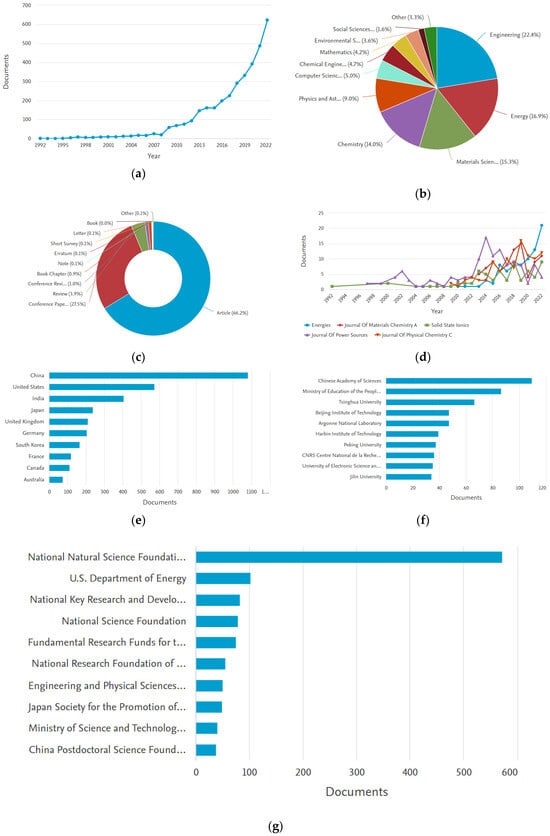
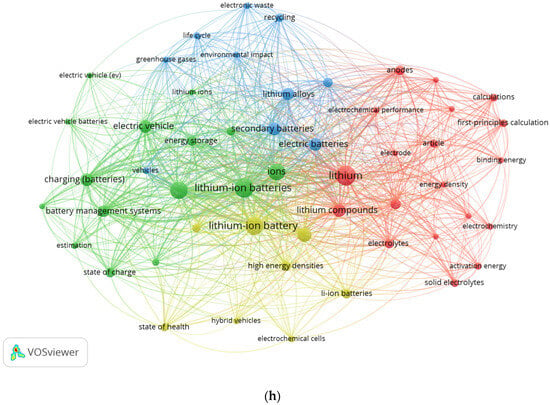
Figure 16.
Electric vehicle lithium-ion battery papers by year (a), subject area (b), document type (c), source (d), country (e), affiliation (f), funding sponsors (g), and important keywords (h).
The majority of research on EV lithium-ion batteries falls within the domains of engineering (1778 documents), energy (1338), materials science (1217), chemistry (1112), and physics and astronomy (710) as depicted in Figure 16b. This distribution shows the multidisciplinary nature of battery research, involving materials development, electrochemistry, physics, and engineering principles. Furthermore, the number of documents in the field of environmental science (286 documents) and the growing interest from social sciences (125 documents) in studying the societal and economic effects of electric vehicle adoption demonstrate the importance of these batteries in tackling energy and environmental issues. The significant presence of 61 documents in the field of decision sciences demonstrates the increasing focus on enhancing battery management and making informed decisions regarding energy policies. Collectively, the wide range of topic areas involved in the research on EV lithium-ion batteries demonstrates the extensive and comprehensive efforts being made to enhance this technology for sustainable transportation and clean energy applications.
Regarding the document type, the research on EV lithium-ion batteries is predominantly communicated through articles (2294 documents) as depicted in Figure 16c, showing a significant emphasis on empirical studies and scientific contributions. Conference papers (952) also have a notable impact, underscoring the significance of sharing information and working together in this domain. Reviews (135) function as exhaustive synopses of the current state of the field, offering useful perspectives on the existing body of knowledge. The inclusion of conference reviews (34), book chapters (31), and notes (5) demonstrates the various modes of academic discourse within the EV lithium-ion battery research community. The diversity observed in this field is a direct result of its complex and interdisciplinary nature. Various publications address diverse topics, ranging from fundamental research to practical application and policy considerations.
Reputable sources actively discuss research on lithium-ion batteries for electric vehicles, as evidenced by Figure 16d. The Journal of Power Sources, with 130 documents, is a prominent place for sharing important discoveries in this field. The interdisciplinary nature of battery research, encompassing both chemistry and materials science, is exemplified by The Journal of Physical Chemistry C (97) and Journal of Materials Chemistry A (87). The journal Energies (82) emphasizes energy-related aspects, while Solid State Ionics (69) highlights the significance of ion conductivity in battery development. The results underscore the extensive and profound scholarly efforts aimed at enhancing the performance and sustainability of EV lithium-ion batteries, with a specific focus on materials, chemistry, and energy-related subjects.
Figure 16e illustrates the geographical diversity of research on EV lithium-ion batteries. China, with 1080 documents, is leading the way as one of the prominent global leaders in EV production and technology advancement. The United States (571) maintains a strong presence, driven by its commitment to EV innovation. India (403) signifies a growing interest in EV batteries as the country transitions to cleaner transportation. Japan (235) and the United Kingdom (209) show the global nature of battery research, while Germany (202) contributes to the European expertise in this domain. South Korea (163) demonstrates its role as one of the major players in the EV industry. France (117), Canada (109), and Australia (73) highlight the international significance of EV lithium-ion battery research.
In EV lithium-ion battery research, notable affiliations include the Chinese Academy of Sciences (109 documents) (Figure 16f), underscoring China’s prominent role in battery innovation, and the Ministry of Education of the People’s Republic of China (86), reflecting strong government support. Tsinghua University (66) and the Beijing Institute of Technology (47) contribute significantly to the academic pursuit of advanced battery technologies. Furthermore, Argonne National Laboratory (47) represents U.S. expertise. The Harbin Institute of Technology (39), Peking University (37), and Jilin University (34) further emphasize China’s academic strength in this field. These results demonstrate the multifaceted contributions from both academic and research institutions in advancing lithium-ion battery technology for EVs, thus highlighting the global effort to enhance EV performance and sustainability.
Research on EV lithium-ion batteries receives substantial funding support from various sources as illustrated in Figure 16g, with the National Natural Science Foundation of China (571) leading the way, highlighting China’s significant investments in battery technology. The U.S. Department of Energy (101) plays a crucial role in advancing battery research in the United States. Additionally, the National Key Research and Development Program of China (82), the National Science Foundation (78), and the Fundamental Research Funds for the Central Universities (74) demonstrate the global commitment to battery innovation. The National Research Foundation of Korea (54) and the Engineering and Physical Sciences Research Council (49) represent international collaboration in battery research. These results emphasize the interdisciplinary and multinational nature of EV lithium-ion battery research, reflecting the imperative to develop advanced battery technologies for the sustainable future of EVs.
Figure 16 and Table 4 provide a comprehensive overview of the occurrence and importance of keywords associated with battery management systems. Table 4 highlights the prevalence of phrases connected to lithium-based technologies, such as “lithium”, “lithium-ion batteries”, and “lithium-ion battery”, which rank highest in terms of both frequency and link strength. The emphasis on lithium in contemporary battery technology, particularly in relation to electric vehicles, underscores its crucial significance. Additional noteworthy terms encompass “ions”, “electric vehicles”, and technical facets such as “Secondary batteries”, “lithium compounds”, and “battery management system”. The use of terminology pertaining to battery components and operations, such as “Anodes”, “Cathodes”, and “charging (batteries)”, highlights the complex technical aspects and practical factors involved in the battery management systems.

Table 4.
Occurrences and total link strength for each keyword for lithium-ion battery.
3.4. Electric Vehicle Battery Management System: Bibliometric Analysis Results
EV battery management system research has experienced substantial growth, with 733 documents published in 2022 as shown in Figure 17a, marking a remarkable surge in recent years. The increasing trend underscores the critical role of battery management systems in optimizing the performance and longevity of batteries in EVs. While prior years also showed steady growth, 2022 stands out as a pinnacle year for battery management system research, reflecting the growing significance of this technology in the advancement of electric mobility. The data indicate that researchers and industries are actively exploring innovative solutions for efficient and sustainable energy storage in EVs, aligning with the broader goal of reducing emissions and promoting eco-friendly transportation solutions.
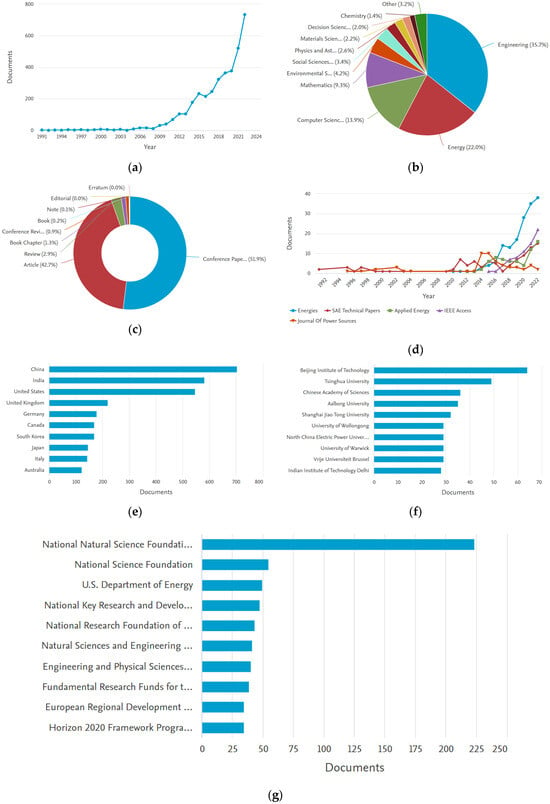
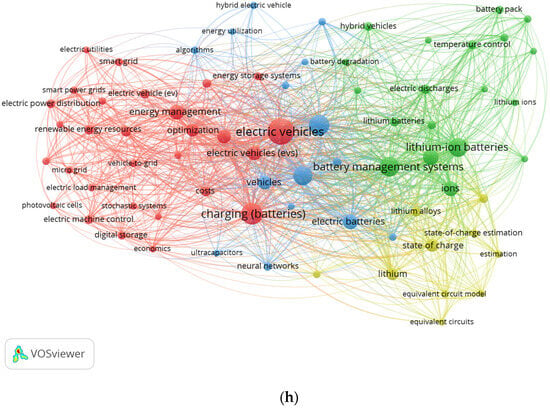
Figure 17.
Electric vehicle battery management system papers by year (a), subject area (b), document type (c), source (d), country (e), affiliation (f), funding sponsors (g), and important keywords (h).
The EV battery management system research spans various subject areas, with the majority of documents falling within engineering (2890 documents), energy (1782), and computer science (1127) as shown in Figure 17b. These subjects highlight the multidisciplinary nature of battery management system technology, which bridges engineering, energy systems, and computational aspects for optimizing EV battery performance. Additionally, Mathematics (754) plays a significant role in modeling and optimizing battery management systems, while environmental science (341) reflects the broader sustainability and environmental implications of this technology. The presence of battery management system research in social sciences (279) and decision sciences (161) underscores the broader societal and decision-making implications of its implementation.
Figure 17c shows the document type of EV battery management system research. It is predominantly published as conference papers (1884 documents) and articles (1547), underlining the practical and academic significance of this technology. Reviews (105) and book chapters (47) play a substantial role in aggregating knowledge and critically evaluating the progress in battery management system. Additionally, conference reviews (34) provide insights into recent developments, while books (6) and notes (2) offer supplementary perspectives. This diverse distribution of document types signifies the various nature of battery management system research, indicating its relevance across various scholarly formats.
EV battery management system articles are distributed across various sources (shown in Figure 17d), with Energies (162 documents) being a prominent source, emphasizing its focus on energy-related research in this field. SAE Technical Papers (96) reflect the technology’s integral role in the automotive industry. Additionally, Applied Energy (69) and IEEE Access (65) contribute significantly, aligning with the multidisciplinary nature of battery management systems. The Journal of Power Sources (55) follows next. These results demonstrate the diverse publication landscape for battery management system research, with various sources actively contributing to its advancement, ultimately shaping the future of efficient and sustainable electric mobility.
EV battery management system research exhibits a global presence as depicted in Figure 17e, with China (702 documents), India (581), and the United States (546) at the three forefronts, reflecting their substantial contributions to the advancement of battery management technology for EVs. The United Kingdom (218) and Germany (177) are also actively engaged, highlighting Europe’s role in the field of battery management systems. Canada (168), South Korea (167), and Japan (144) emphasize the international reach of research in battery management systems, particularly in Asia. Italy (142) and Australia (121) also contribute significantly to the global landscape.
Within the field of battery management system research, it is worth noting the significant involvement and dedication of prominent institutions such as the Beijing Institute of Technology (64 documents) and Tsinghua University (49) from China as shown in Figure 17f. Moreover, the Chinese Academy of Sciences (36) further highlights China’s substantial presence and commitment to fostering battery management system innovation. Also, institutions like Aalborg University (35) and Shanghai Jiao Tong University (32) follow next. It is also worth noting that institutions such as the University of Wollongong, North China Electric Power University, University of Warwick, Vrije Universiteit Brussel, and Indian Institute of Technology Delhi have made significant contributions to the advancement of battery management systems. These institutions have collectively produced a substantial number of documents, with each institution having 29 or 28 documents, demonstrating their commitment to fostering global collaboration in the pursuit of enhancing battery management system technologies.
Research on EV battery management systems is well supported financially as illustrated in Figure 17g, with funding coming from various sources. The National Natural Science Foundation of China (223 documents) stands as the primary sponsor, reflecting China’s commitment to advancing battery management technology for EVs. The National Science Foundation (54) in the United States plays a significant role, emphasizing the nation’s focus on this crucial technology. The U.S. Department of Energy (49) further supports research and development in this area. Additionally, the National Key Research and Development Program of China (47), National Research Foundation of Korea (43), Natural Sciences and Engineering Research Council of Canada (41), Engineering and Physical Sciences Research Council (40) in the UK, and other funders such as the European Regional Development Fund (34) and Horizon 2020 Framework Programme (34) highlight the international interest and recognition of the importance of battery management systems in enhancing the performance and sustainability of EVs.
Figure 17h and Table 5 provide comprehensive examinations of the terms associated with battery management systems, emphasizing their frequency and overall connection strength in a particular dataset. “Electric vehicles” dominate the rankings in terms of both frequency and connection strength, highlighting their pivotal position in conversations around battery management. The prominence of “charging (batteries)” and “battery management systems” suggests a significant emphasis on the charging procedures and the managerial elements of batteries in electric vehicles. The term “electric vehicle” and related terms such as “lithium-ion batteries” and “Secondary batteries” emphasize the significance of battery technology in electric transportation. Additional noteworthy terms encompass “Ions”, “lithium-ion battery”, and “electric batteries”, which pertain to the intricate aspects of battery structure and operation. The use of phrases such as “energy management”, “State of charge”, and “optimization” indicates the emphasis on maximizing energy efficiency and optimizing battery performance in battery management systems. The table comprehensively encompasses the several aspects of battery management in the domain of electric vehicles, ranging from detailed technical details to more primary energy and vehicle principles.

Table 5.
Occurrences and total link strength for each keyword for battery management system.
3.5. Electric Vehicle Charging Infrastructure: Bibliometric Analysis Results
The number of articles related to EV charging infrastructure has exhibited significant growth in recent years as can be seen in Figure 18a. In 2022, there were 515 documents, marking a substantial increase from previous years. This trend reflects the heightened global interest and investment in EV charging infrastructure as part of the transition to sustainable transportation. The year 2021 saw 343 documents, indicating consistent research and development efforts in the field. The years 2020 and 2019 had 266 and 258 documents, respectively, suggesting a steady upward trajectory. Notably, there was a sharp increase in publications from 2016 onwards, with 158 documents in 2017 and 135 in 2016, demonstrating a turning point in the prominence of this topic. While there were only a few publications in the early 2000s, the continuous rise in research output since then underscores the growing importance of EV charging infrastructure in the context of electric mobility and environmental sustainability.
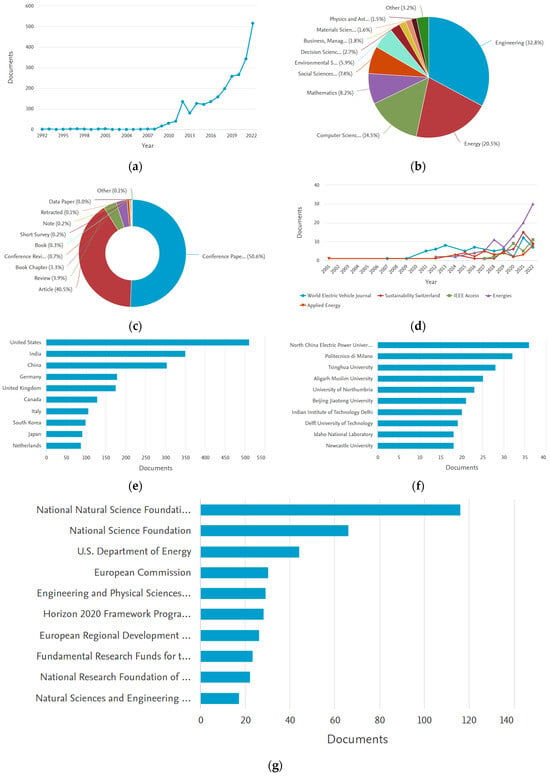
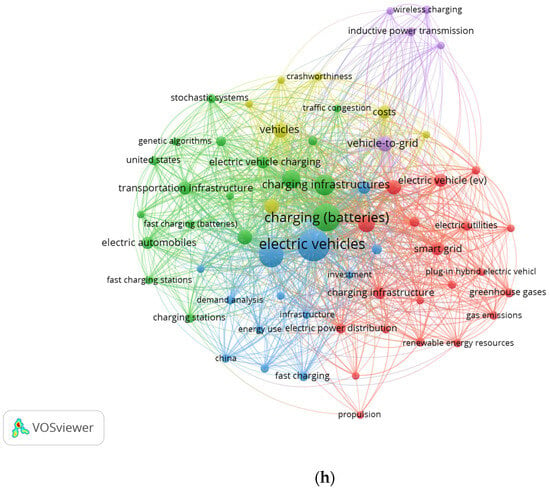
Figure 18.
Electric vehicle charging infrastructure papers by year (a), subject area (b), document type (c), source (d), country (e), affiliation (f), funding sponsors (g), and important keywords (h).
The distribution of EV charging infrastructure articles across subject areas reflects a multidisciplinary nature (Figure 18b), with engineering as the most prevalent category, encompassing 1779 documents. This shows the prominent role of engineering disciplines in advancing research and innovation in EV charging infrastructure. Energy and computer science follow closely behind with 1111 and 786 documents, respectively, indicating the significance of energy-related research and the application of computational methods in this field. Mathematics also plays a substantial role with 444 documents, often involved in modeling and optimization aspects. Social sciences and environmental science demonstrate the interdisciplinary nature of the topic, reflecting the social and environmental implications of EV charging infrastructure deployment. Additionally, decision sciences, business, Management and Accounting, and materials science are represented, highlighting the economic and materials aspects of EV charging infrastructure. This diversified distribution across subject areas highlights the comprehensive nature of research in this domain, where technical, social, economic, and environmental dimensions intersect.
The distribution of document types for EV charging infrastructure articles (Figure 18c) reveals that conference paper is the dominant category with 1236 documents, highlighting the substantial contribution of research presented at academic conferences. Article follows closely behind with 990 documents, indicating the prevalence of peer-reviewed journal articles in disseminating findings in this field. Reviews, book chapters, and conference reviews also make significant contributions with 96, 80, and 18 documents, respectively. The presence of various document types signifies the diverse range of scholarly outputs in the study of EV charging infrastructure, from in-depth research papers to comprehensive reviews and conference contributions, demonstrating the multidimensional nature of this research area.
The source distribution of EV charging infrastructure articles indicates that Energies stands out with the highest number of documents at 94, emphasizing its significance as a publication outlet for research in this domain (Figure 18d). The World Electric Vehicle Journal and Sustainability also contribute significantly with 65 and 40 documents, respectively, highlighting their roles in disseminating knowledge related to EV charging infrastructure. Applied Energy and IEEE Access further complement the research landscape with 33 and 32 documents, showing the multidisciplinary nature of this field and the diverse platforms used to share findings and insights. This distribution reflects the broad interest and collaboration among researchers and institutions worldwide in the field of EV charging infrastructure.
The distribution of research on EV charging infrastructure articles by country/territory highlights a global interest in this field as can be seen in Figure 18e. The United States leads with 510 documents, showcasing its significant contributions to EV charging technology. India (349) and China (303) also make substantial contributions, reflecting their commitment to advancing EV adoption and infrastructure development. Germany (178) and the United Kingdom (174) demonstrate strong European participation, while Canada (128) and Italy (105) further represent the global reach of EV charging research. This widespread interest demonstrates the international effort to create efficient and sustainable charging networks to support the growing EV market.
The affiliation landscape for EV charging infrastructure research showcases a diverse set of institutions contributing to this field, as shown in Figure 18f. North China Electric Power University leads with 36 documents, reflecting China’s dedication to advancing EV charging technology. Politecnico di Milano (32) and Tsinghua University (28) represent the Italian and Chinese academic communities, respectively. Aligarh Muslim University (25) and the University of Northumbria (23) contribute from India and the United Kingdom, respectively. This global collaboration shows the importance of a multi-faceted approach to developing EV charging infrastructure to support the growing EV technology.
The funding landscape for EV charging infrastructure research (Figure 18g) is characterized by a significant contribution from the National Natural Science Foundation of China (116 documents), highlighting China’s leadership in this domain. The National Science Foundation (66) and the U.S. Department of Energy (44) signify the United States’ commitment to advancing this technology. The European Commission (30) and the Horizon 2020 Framework Programme (28) emphasize the European Union’s role in supporting research in this area. These results demonstrate the global nature of EV charging infrastructure research, with funding from various sources aimed at driving innovation and sustainability in the transportation sector.
Figure 18h and Table 6 provide a concise overview of the frequency and overall link strengths of the keywords associated with charging infrastructure, highlighting the significance of these phrases. Electric vehicles have the highest frequency and link strength, indicating their significant involvement in debates over charging infrastructure. The frequent reference to “charging (batteries)” and “electric vehicle” highlights the emphasis on the charging procedure and the infrastructure needs of electric vehicles. The use of specific words such as “charging infrastructures”, “electric power transmission networks”, and “vehicle-to-grid” implies a comprehensive examination of the several facets of electric car charging, encompassing the wider network and integration with the grid. The inclusion of phrases such as “optimization”, “Secondary batteries”, and “charging station” suggests a specific emphasis on the efficiency and technological components of charging facilities. Furthermore, the incorporation of “transportation infrastructure”, “smart grid”, and “costs” indicates the economic and logistical factors involved in the development of charging infrastructure. The table comprehensively represents the diverse characteristics of charging infrastructure advancement for electric vehicles, including technological, economic, and planning elements.

Table 6.
Occurrences and total link strength for each keyword for charging infrastructure.
3.6. Electric Vehicle Smart Charging: Bibliometric Analysis Results
Smart charging research in the field of EVs has witnessed significant growth, with a notable increase in publications in recent years as shown in Figure 19a. In 2022, there were 392 documents, marking a substantial surge in research output. The trend indicates a growing focus on optimizing EV charging infrastructure and technologies for improved efficiency and grid integration. While prior years also saw steady growth, 2022 stands out as a pinnacle year for smart charging research, reflecting the increasing importance of this technology in the transition towards sustainable and grid-friendly EV adoption. The data suggest that researchers and industries are actively exploring innovative solutions for EV charging to meet the evolving needs of electric mobility.

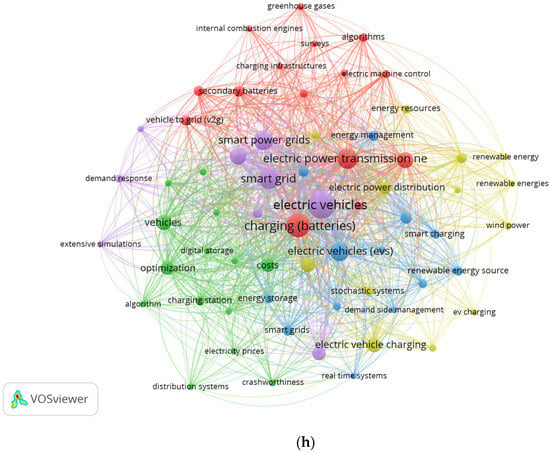
Figure 19.
Electric vehicle smart charging papers by year (a), subject area (b), document type (c), source (d), country (e), affiliation (f), funding sponsors (g), and important keywords (h).
The research on EV smart charging spans a broad spectrum of subject areas, with the majority of articles falling within engineering (1843 documents), energy (1285), and computer science (1258) as shown in Figure 19b. These subjects highlight the multidisciplinary nature of smart charging technology, which bridges engineering, energy systems, and computational aspects for optimizing EV charging. Additionally, the presence of research in Mathematics (588) emphasizes the analytical and modeling aspects of smart charging. Social sciences (221), environmental science (173), and decision sciences (134) reflect the broader societal and decision-making implications of EV smart charging. These results underline the interdisciplinary significance of smart charging in transforming the EV landscape, aligning with environmental goals, and shaping the future of sustainable transportation systems.
EV smart charging research is predominantly published as conference papers (1522 documents) and articles (959) as illustrated in Figure 19c. This signifies the active dissemination of research findings through academic conferences and scholarly journals, demonstrating the practical and academic significance of smart charging technology. Book chapters (67) and reviews (62) contribute to critically evaluating the progress in EV smart charging technology. The diverse distribution of document types, including conference reviews, books, notes, and Data Papers, underscores the multifaceted nature of smart charging research. This indicates the relevance of EV smart charging across various academic formats.
EV smart charging articles are dispersed across several journals, with Energies (103 documents) serving as a prominent source, reflecting its emphasis on energy-related research as shown in Figure 19d. IEEE Transactions on Smart Grid (69) and IEEE Access (63) indicate the significance of smart charging in grid integration and accessibility, aligning with the evolving landscape of electric mobility. Additionally, Applied Energy (40) and Energy (28) contribute to the broader energy sector’s interest in smart charging technology. The results highlight the diverse publication landscape for smart charging research, with various sources actively contributing to its advancement, ultimately shaping the future of sustainable electric mobility.
Figure 19e shows that EV smart charging research exhibits global interest, with China (441 documents) and the United States (431) at the forefront, highlighting their commitment to advancing EV infrastructure and technology. India (319) follows closely. The United Kingdom (202) and Canada (173) also play significant roles, reflecting their dedication to sustainable transportation. Germany (150), Italy (130), and Australia (98) contribute to the European and Oceanian perspectives on smart charging, while South Korea (98) and Portugal (85) underscore the global reach and collaborative nature of research in EV smart charging. These results demonstrate the international focus on smart charging technology, which is seen as pivotal in accelerating the adoption of EVs and promoting eco-friendly transportation solutions worldwide.
Institutional involvement in EV smart charging research is widespread, with the Technical University of Denmark (42 documents) and Universidade do Minho (37) making notable contributions, indicating their expertise in the field as depicted in Figure 19f. North China Electric Power University (35) and Tsinghua University (35) from China, alongside the University of Northumbria (30) in the UK, actively engage in advancing smart charging technologies. The Institute for Systems and Computer Engineering, Technology, and Science (29) is a key player in research and innovation. These affiliations, along with the Ministry of Education of the People’s Republic of China (27), Aalborg University (27), and Universidade do Porto (26), reflect global interest and emphasize the multifaceted nature of smart charging research, with academic and institutional partnerships driving innovation in sustainable electric vehicle charging solutions.
EV smart charging research receives substantial funding support, with the National Natural Science Foundation of China (148 documents) taking the lead, demonstrating China’s commitment to this technology as shown in Figure 19g. The National Science Foundation (60) in the United States also plays a significant role, reflecting the nation’s focus on smart charging solutions. The Engineering and Physical Sciences Research Council (49) in the UK, along with contributions from the Horizon 2020 Framework Programme (39) and Fundação para a Ciência e a Tecnologia (35) in Portugal, underscores the international nature of funding initiatives. Moreover, the European Commission (34) and European Regional Development Fund (32) highlight Europe’s financial backing for smart charging projects. Funding agencies such as the U.S. Department of Energy (29) and the Natural Sciences and Engineering Research Council of Canada (24) further support research and development in this critical area, emphasizing the global recognition of smart charging’s pivotal role in the transition to sustainable electric mobility.
Figure 19h and Table 7 specifically examine the frequency and overall strength of connections between the phrases that are associated with smart charging, a crucial component of electric vehicle technology. The term “electric vehicles” is the most frequently mentioned and has the strongest connections, indicating its importance in conversations about smart charging. The high prevalence of “charging (batteries)” shows a particular focus on the charging component of EVs. The notable existence of “smart grid” and “electric power transmission networks”, in addition to “smart power grids”, highlights the crucial significance of sophisticated grid technologies in the context of EV charging. These concepts indicate a transition towards energy distribution systems that are increasingly interconnected and sophisticated, which are crucial for the effective charging of electric vehicles. The phrase “vehicle-to-grid” and its derivatives, such as “vehicle to grid (V2G)”, emphasize the two-way exchange of energy between vehicles and the power grid, which is a fundamental aspect of intelligent charging. The inclusion of phrases such as “optimization”, “electric vehicle charging”, and “Scheduling” suggests a specific emphasis on improving the efficiency and efficacy of the charging process. The table also encompasses broader aspects of energy management and environmental considerations in the field of smart charging for electric vehicles, including terminology such as “Secondary batteries”, “renewable energy resources”, and “electric utilities”.

Table 7.
Occurrences and total link strength for each keyword for smart charging.
3.7. Electric Vehicle Vehicle-to-Everything: Bibliometric Analysis Results
The term “vehicle-to-everything” (V2X) refers to technologies that allow vehicles to communicate with different elements such as other vehicles (V2V), infrastructure (V2I), networks (V2N), and pedestrians (V2P). This communication helps improve road safety, manages traffic more efficiently, and supports the development of autonomous driving.
Figure 20a shows the trend of published papers with a keyword of V2X indexed by the Scopus database from 1990 to 2022. A total of 4164 articles were found. Over the past few decades, research and interest in V2X technology have seen remarkable progress. In the early 1990s, V2X-related documents were relatively scarce, with just a handful in 1991 and 1992. However, as technology advanced and the potential applications of V2X became more apparent, the number of documents began to grow gradually in the late 1990s and early 2000s. By the mid-2010s, there was a noticeable increase in V2X-related publications, indicating an increased interest and recognition of its importance. The year 2016 marked a significant turning point, witnessing a substantial increase in the number of documents published, which continued to rise in subsequent years. In 2020 and 2021, there was a particularly noticeable surge, reflecting a growing emphasis on V2X technology as it becomes increasingly relevant in the fields of transportation and communication.
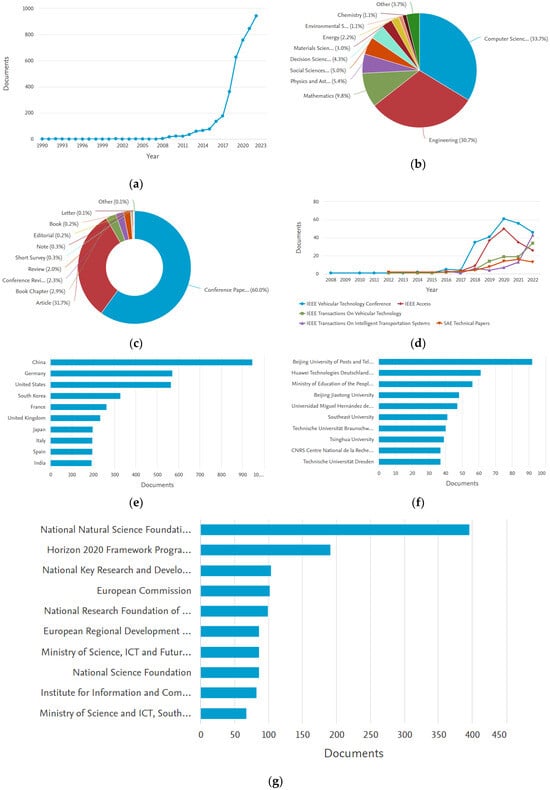

Figure 20.
Electric vehicle: vehicle-to-everything papers by year (a), subject area (b), document type (c), source (d), country (e), affiliation (f), funding sponsors (g), and important keywords (h).
V2X research spans a diverse range of subject areas as shown in Figure 20b, with the majority of documents falling within computer science (3205 documents) and engineering (2922). These numbers reflect the extensive interdisciplinary nature of V2X technology, bridging computer science and engineering to develop innovative solutions for intelligent transportation systems. Mathematics (929) plays a significant role in modeling and optimizing V2X communication and applications, while physics and astronomy (518) contribute to the technical understanding of V2X systems. Moreover, the presence of V2X research in social sciences (471) and decision sciences (407) highlights the broader societal and decision-making implications of V2X technology.
V2X research is predominantly published in the form of conference papers (2498 documents) and articles (1321) as shown in Figure 20c. These document types signify the active dissemination of V2X findings through academic conferences and scholarly journals. Additionally, book chapters (120) play a significant role in aggregating V2X knowledge. Conference reviews (95) and reviews (83) contribute to the critical evaluation and synthesis of V2X research, while other document types such as Short Surveys (13), notes (12), Editorials (8), and books (7) provide supplementary insights and perspectives.
V2X research is prominently featured in various journals indexed in the Scopus database as shown in Figure 20d. Notably, IEEE-related sources, including the IEEE Vehicular Technology Conference, IEEE Access, IEEE Transactions On Vehicular Technology, and IEEE Transactions On Intelligent Transportation Systems contribute the majority of these documents (590 documents). The presence of 62 V2X-related papers in SAE Technical Papers demonstrates the technology’s integral role in the automotive industry.
Figure 20e shows a global landscape of V2X research, with China leading with 944 articles, followed by Germany (570) and the United States (563). These numbers reflect China’s notable investments in EVs and smart transportation. The presence of these three countries as frontrunners signifies their strong automotive and technological sectors. South Korea (326), France (262), the United Kingdom (232), Japan (197), Italy (195), Spain (194), and India (191) also actively contribute to V2X research. This distribution of documents showcases the widespread international interest in developing sustainable transportation solutions.
The provided affiliation data shed light on the institutions actively contributing to V2X research in the Scopus database (Figure 20f). The Beijing University of Posts and Telecommunications leads with 92 articles, followed by Huawei Technologies Deutschland GmbH (61) and the Ministry of Education of the People’s Republic of China (56). These affiliations highlight the significant role of Chinese institutions and tech companies in advancing V2X technology. Other notable contributors include European institutions such as Technische Universität Braunschweig, Technische Universität Dresden, and CNRS Centre National de la Recherche Scientifique, underlining the international collaboration in V2X research. The results reflect the global interest in V2X technology, with China’s strong presence, both in academia and industry, emphasizing its commitment to V2X innovation.
V2X research receives substantial funding from various sources, with the National Natural Science Foundation of China leading with 395 documents (Figure 20g). Horizon 2020 Framework Programme (191) and the National Key Research and Development Program of China (103) are the next significant contributors. The European Commission (101), National Research Foundation of Korea (99), and European Regional Development Fund (86) demonstrate Europe’s commitment to V2X technology. Particularly, governmental support is evident, with organizations like the Ministry of Science, ICT, and Future Planning (86) in South Korea, the National Science Foundation (86) in the United States, and the Institute for Information and Communications Technology Promotion (82) in South Korea. These results indicate the global recognition of V2X’s importance, with substantial funding to drive innovation and research efforts in this transformative field.
Figure 20h and Table 8 display the frequency of keywords and the overall strength of links in relation to vehicle-to-everything (V2X) technology. The primary keywords are “vehicle to vehicle communications” and “vehicles”, highlighting a significant emphasis on the communication component of vehicular technologies. The prominent existence of the “5g mobile communication system” signifies the crucial role of improved telecommunications in facilitating V2X interactions. Additional terms such as “intelligent systems”, “intelligent vehicle highway system”, and “motor transportation” indicate a wider emphasis on incorporating intelligence and automation into transportation systems. The addition of “wireless telecommunication systems” and “vehicular communications” underscores the significance of wireless technology in enabling vehicle connectivity. The term “V2X”, as well as related ideas such as “vehicular ad hoc networks” and “autonomous vehicles”, emphasizes the dynamic development of vehicle communication systems. Furthermore, the inclusion of “long-term evolution (LTE)”, “mobile telecommunication systems”, and “IEEE standards” indicates the technological foundations and standardization endeavors in V2X technology. The table comprehensively represents the diverse characteristics of V2X technology, including communication, intelligence, and network security, throughout contemporary transportation systems.

Table 8.
Occurrences and total link strength for each keyword for V2X.
4. Conclusions: The Synergy of Electric Vehicle Policy, Battery Technology, Charging Infrastructure, and V2X for Sustainable Mobility
In this paper, we have comprehensively reviewed EV trends, policies, lithium-ion batteries, battery management systems, charging infrastructures, smart charging infrastructures, and V2X. EV publication has had exponential growth in recent years and the potential to reach more than 20,000 articles by the end of 2024. This growth trend is in line with global EV sales. Furthermore, the field of engineering and energy accounted for over 50% of the subject area, indicating the expansion of EV technology. This phenomenon shows that EVs are a hot topic in academia and industry fields. Nevertheless, there has been limited exploration (~10%) of the social, economic, and environmental aspects of EV research based on the subject area, despite its significance in determining the extent of EV adoption within the community. Based on by country, China emerged as the leading country in EV research, with a total of 3700 published articles based on the selected keywords. However, the United States maintained its dominance in the specific keyword “charging infrastructure”. China has achieved a high level of proficiency in all areas of EVs, with a particular focus on lithium-ion batteries, which have been the subject of over a thousand research studies.
Our analysis has provided insights into the critical role of EV policies in shaping the future EV technology. We have also investigated the advancement of battery management systems, emphasizing its importance in enhancing the efficiency and durability of EV batteries. In addition, we have examined the advancements in EV charging infrastructures, with a specific emphasis on EV smart charging technologies. Ultimately, a thorough evaluation has been conducted on the transformative capacity of V2X to revolutionize both the electric vehicle and energy industries.
The analysis from the present study clearly demonstrates that the interplay of EV policies, battery technologies, charging infrastructures, and new EV technologies is crucial for the ongoing expansion and success of electric vehicles. A cohesive integration of EV policies, cutting-edge battery technologies, charging infrastructures, and V2X communication is crucial for fully harnessing the capabilities of EVs and tackling the obstacles of sustainable mobility.
5. Future Recommendations for Advancing Electric Vehicle Development and Sustainability
To further the progress of EV development, several areas of focus have been identified for future research. First and foremost, it is necessary to achieve harmonization of EV policies. This entails the identification of optimal methodologies in the establishment of EV policies with the aim of promoting global cooperation and establishing a uniform regulatory framework that encourages the widespread use of EVs. Furthermore, research on battery technology is crucial, with a specific emphasis on lithium-ion batteries, as well as investigating other energy storage options in order to improve battery efficiency, safety, and environmental friendliness.
Furthermore, the development of smart charging solutions is essential, prioritizing grid integration and implementing real-time demand–response technologies to optimize energy use and minimize peak loads. Ensuring the widespread adoption and standardization of vehicle-to-everything technologies is important for seamless communication between electric vehicles, infrastructure, and the grid.
Thorough evaluations of the environmental effects of EV adoption are also crucial. These should encompass the examination of the life cycle of batteries and the evaluation of charging infrastructures to ensure the long-term viability of sustainable transportation. To promote the wider acceptance and successful integration of V2X technologies, it is important to enhance the EV user experience by means of education and user-friendly interfaces. Collaboration among automakers, energy providers, policymakers, and researchers is essential to stimulate innovation, tackle difficulties, and expedite the shift towards sustainable electric vehicle technology.
All in all, the future of electric mobility is promising, but it relies on continued research, innovation, and collaboration across various sectors. Addressing the outlined recommendations will be instrumental in shaping a sustainable and electrifying future mobility. Figure 21 shows the future recommendations from this study.
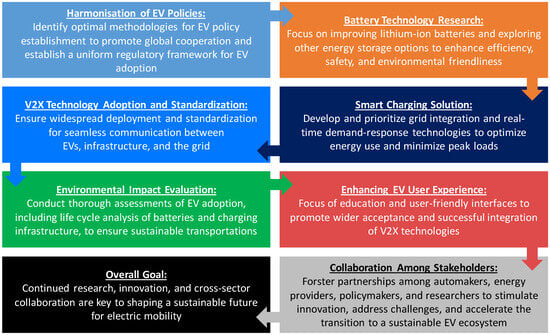
Figure 21.
Future recommendations.
Funding
The work is supported by STIRF grant RG2023-1671 (cost centre: 015LA0-051) from Universiti Teknologi PETRONAS (UTP), Malaysia.
Conflicts of Interest
The authors declare no conflict of interest.
Nomenclature
| BMS | battery management systems |
| EV | electric vehicles |
| EMS | energy management scheme |
| ICEVs | internal combustion engine vehicles |
| LCCA | life cycle cost analysis |
| LIBs | lithium-ion batteries |
| V2X | vehicle-to-everything |
| V2H | vehicle-to-home |
| V2G | vehicle-to-grid |
| V2H | vehicle-to-home |
| V2L | vehicle-to-load |
| V2V | vehicle-to-vehicle |
| TMS | thermal management system |
References
- Ghosh, A. Possibilities and Challenges for the Inclusion of the Electric Vehicle (EV) to Reduce the Carbon Footprint in the Transport Sector: A Review. Energies 2020, 13, 2602. [Google Scholar] [CrossRef]
- Veza, I.; Abas, M.A.; Djamari, D.W.; Tamaldin, N.; Endrasari, F.; Budiman, B.A.; Idris, M.; Opia, A.C.; Juangsa, F.B.; Aziz, M. Electric Vehicles in Malaysia and Indonesia: Opportunities and Challenges. Energies 2022, 15, 2564. [Google Scholar] [CrossRef]
- Kumar, R.R.; Alok, K. Adoption of electric vehicle: A literature review and prospects for sustainability. J. Clean. Prod. 2020, 253, 119911. [Google Scholar] [CrossRef]
- Wang, H.; He, X.; Liang, X.; Choma, E.F.; Liu, Y.; Shan, L.; Zheng, H.; Zhang, S.; Nielsen, C.P.; Wang, S.; et al. Health benefits of on-road transportation pollution control programs in China. Proc. Natl. Acad. Sci. USA 2020, 117, 25370–25377. [Google Scholar] [CrossRef] [PubMed]
- Tang, J.; McNabola, A.; Misstear, B. The potential impacts of different traffic management strategies on air pollution and public health for a more sustainable city: A modelling case study from Dublin, Ireland. Sustain. Cities Soc. 2020, 60, 102229. [Google Scholar] [CrossRef]
- Syuhada, G.; Akbar, A.; Hardiawan, D.; Pun, V.; Darmawan, A.; Heryati, S.H.A.; Siregar, A.Y.M.; Kusuma, R.R.; Driejana, R.; Ingole, V.; et al. Impacts of Air Pollution on Health and Cost of Illness in Jakarta, Indonesia. Int. J. Environ. Res. Public Health 2023, 20, 2916. [Google Scholar] [CrossRef]
- Das, J. Comparative life cycle GHG emission analysis of conventional and electric vehicles in India. Environ. Dev. Sustain. 2022, 24, 13294–13333. [Google Scholar] [CrossRef]
- Sanguesa, J.A.; Torres-Sanz, V.; Garrido, P.; Martinez, F.J.; Marquez-Barja, J.M. A Review on Electric Vehicles: Technologies and Challenges. Smart Cities 2021, 4, 372–404. [Google Scholar] [CrossRef]
- Arias, N.B.; Hashemi, S.; Andersen, P.B.; Træholt, C.; Romero, R. Assessment of economic benefits for EV owners participating in the primary frequency regulation markets. Int. J. Electr. Power Energy Syst. 2020, 120, 105985. [Google Scholar] [CrossRef]
- Debnath, R.; Bardhan, R.; Reiner, D.M.; Miller, J.R. Political, economic, social, technological, legal and environmental dimensions of electric vehicle adoption in the United States: A social-media interaction analysis. Renew. Sustain. Energy Rev. 2021, 152, 111707. [Google Scholar] [CrossRef]
- Makarova, I.; Buyvol, P.; Shubenkova, K.; Fatikhova, L.; Parsin, G. Editorial: Sustainable transport systems. Front. Built Environ. 2023, 9, 1161361. [Google Scholar] [CrossRef]
- Sun, X.; Li, Z.; Wang, X.; Li, C. Technology Development of Electric Vehicles: A Review. Energies 2019, 13, 90. [Google Scholar] [CrossRef]
- Cai, W.; Wu, X.; Zhou, M.; Liang, Y.; Wang, Y. Review and Development of Electric Motor Systems and Electric Powertrains for New Energy Vehicles. Automot. Innov. 2021, 4, 3–22. [Google Scholar] [CrossRef]
- Zeng, X.; Li, M.; Abd El-Hady, D.; Alshitari, W.; Al-Bogami, A.S.; Lu, J.; Amine, K. Commercialization of Lithium Battery Technologies for Electric Vehicles. Adv. Energy Mater. 2019, 9, 1900161. [Google Scholar] [CrossRef]
- Balasingam, B.; Ahmed, M.; Pattipati, K. Battery Management Systems—Challenges and Some Solutions. Energies 2020, 13, 2825. [Google Scholar] [CrossRef]
- Amjad, M.; Ahmad, A.; Rehmani, M.H.; Umer, T. A review of EVs charging: From the perspective of energy optimization, optimization approaches, and charging techniques. Transp. Res. Part D Transp. Environ. 2018, 62, 386–417. [Google Scholar] [CrossRef]
- Wang, S.; Li, J.; Zhao, D. The impact of policy measures on consumer intention to adopt electric vehicles: Evidence from China. Transp. Res. Part A Policy Pract. 2017, 105, 14–26. [Google Scholar] [CrossRef]
- Shao, J.; Yang, H.; Zhang, A. Adoption of electric vehicles: Manufacturers’ incentive and government policy. J. Trans. Econ. Policy (JTEP) 2019, 53, 175–198. [Google Scholar]
- Münzel, C.; Plötz, P.; Sprei, F.; Gnann, T. How large is the effect of financial incentives on electric vehicle sales?—A global review and European analysis. Energy Econ. 2019, 84, 104493. [Google Scholar] [CrossRef]
- Wang, N.; Pan, H.; Zheng, W. Assessment of the incentives on electric vehicle promotion in China. Transp. Res. Part A Policy Pr. 2017, 101, 177–189. [Google Scholar] [CrossRef]
- Shi, L.; Hao, Y.; Lv, S.; Cipcigan, L.; Liang, J. A comprehensive charging network planning scheme for promoting EV charging infrastructure considering the Chicken-Eggs dilemma. Res. Transp. Econ. 2020, 88, 100837. [Google Scholar] [CrossRef]
- Thorne, Z.; Hughes, L. Evaluating the effectiveness of electric vehicle subsidies in Canada. Procedia Comput. Sci. 2019, 155, 519–526. [Google Scholar] [CrossRef]
- Helveston, J.P.; Liu, Y.; Feit, E.M.; Fuchs, E.; Klampfl, E.; Michalek, J.J. Will subsidies drive electric vehicle adoption? Measuring consumer preferences in the U.S. and China. Transp. Res. Part A Policy Pract. 2015, 73, 96–112. [Google Scholar] [CrossRef]
- Noor-A-Rahim, M.; Liu, Z.; Lee, H.; Khyam, M.O.; He, J.; Pesch, D.; Moessner, K.; Saad, W.; Poor, H.V. 6G for vehicle-to-everything (V2X) communications: Enabling technologies, challenges, and opportunities. Proc. IEEE 2022, 110, 712–734. [Google Scholar] [CrossRef]
- Khan, A.A.; Laghari, A.A.; Shafiq, M.; Awan, S.A.; Gu, Z. Vehicle to Everything (V2X) and Edge Computing: A Secure Lifecycle for UAV-Assisted Vehicle Network and Offloading with Blockchain. Drones 2022, 6, 377. [Google Scholar] [CrossRef]
- Inci, M.; Savrun, M.M.; Çelik, Ö. Integrating electric vehicles as virtual power plants: A comprehensive review on vehicle-to-grid (V2G) concepts, interface topologies, marketing and future prospects. J. Energy Storage 2022, 55, 105579. [Google Scholar] [CrossRef]
- Mojumder, R.H.; Antara, F.A.; Hasanuzzaman; Alamri, B.; Alsharef, M. Electric Vehicle-to-Grid (V2G) Technologies: Impact on the Power Grid and Battery. Sustainability 2022, 14, 13856. [Google Scholar] [CrossRef]
- Borge-Diez, D.; Icaza, D.; Açıkkalp, E.; Amaris, H. Combined vehicle to building (V2B) and vehicle to home (V2H) strategy to increase electric vehicle market share. Energy 2021, 237, 121608. [Google Scholar] [CrossRef]
- Chen, J.; Zhang, Y.; Li, X.; Sun, B.; Liao, Q.; Tao, Y.; Wang, Z. Strategic integration of vehicle-to-home system with home distributed photovoltaic power generation in Shanghai. Appl. Energy 2020, 263, 114603. [Google Scholar] [CrossRef]
- Kumar, S.; Ramalingam, B.; Yadav, K. A Novel Circuit Topology for Vehicle to Load (V2L) Application. In Proceedings of the 2023 9th International Conference on Electrical Energy Systems (ICEES), Chennai, India, 23–25 March 2023; pp. 300–305. [Google Scholar]
- Pervez, I.; Antoniadis, C.; Ghazzai, H.; Massoud, Y. Solar-Powered Vehicle-to-Load (V2L) Plug-in Electric Vehicles: Alleviation of the Photovoltaic Power Decay. In Proceedings of the 2023 IEEE International Conference on Smart Mobility (SM), Thuwal, Saudi Arabia, 19–21 March 2023; pp. 144–148. [Google Scholar]
- Elagin, V.; Spirkina, A.; Buinevich, M.; Vladyko, A. Technological Aspects of Blockchain Application for Vehicle-to-Network. Information 2020, 11, 465. [Google Scholar] [CrossRef]
- Khan, A.R.; Jamlos, M.F.; Osman, N.; Ishak, M.I.; Dzaharudin, F.; Yeow, Y.K.; Khairi, K.A. DSRC technology in Vehicle-to-Vehicle (V2V) and Vehicle-to-Infrastructure (V2I) IoT system for Intelligent Transportation System (ITS): A review. In Recent Trends in Mechatronics Towards Industry 4.0: Selected Articles from iM3F 2020, Malaysia; Springer: Berlin/Heidelberg, Germany, 2022; pp. 97–106. [Google Scholar]
- Khalid, S.; Abidin, H.Z.; Mazalan, L.; Abdullah, S.A.C. Optimising Video Transmission Performance in 5G New Radio Technology for Vehicle-to-Network (V2N) Application: A Comprehensive Analysis. In Proceedings of the 2023 11th International Conference on Information and Communication Technology (ICoICT), Melaka, Malaysia, 23–24 August 2023; pp. 487–492. [Google Scholar]
- Khan, M.A.; Pattnaik, D.; Ashraf, R.; Ali, I.; Kumar, S.; Donthu, N. Value of special issues in the journal of business research: A bibliometric analysis. J. Bus. Res. 2020, 125, 295–313. [Google Scholar] [CrossRef]
- Shukla, A.K.; Janmaijaya, M.; Abraham, A.; Muhuri, P.K. Engineering applications of artificial intelligence: A bibliometric analysis of 30 years (1988–2018). Eng. Appl. Artif. Intell. 2019, 85, 517–532. [Google Scholar] [CrossRef]
- Kokol, P.; Vošner, H.B.; Završnik, J. Application of bibliometrics in medicine: A historical bibliometrics analysis. Health Inf. Libr. J. 2021, 38, 125–138. [Google Scholar] [CrossRef] [PubMed]
- Smith, K.; Marinova, D. Use of bibliometric modelling for policy making. Math. Comput. Simul. 2005, 69, 177–187. [Google Scholar] [CrossRef]
- Donthu, N.; Kumar, S.; Mukherjee, D.; Pandey, N.; Lim, W.M. How to conduct a bibliometric analysis: An overview and guidelines. J. Bus. Res. 2021, 133, 285–296. [Google Scholar] [CrossRef]
- De Oliveira, O.J.; Da Silva, F.F.; Juliani, F.; Barbosa, L.C.F.M.; Nunhes, T.V. Bibliometric method for mapping the state-of-the-art and identifying research gaps and trends in literature: An essential instrument to support the development of scientific projects. In Scientometrics Recent Advances; Intech: London, UK, 2019. [Google Scholar] [CrossRef]
- Öztürk, O.; Kocaman, R.; Kanbach, D.K. How to design bibliometric research: An overview and a framework proposal. Rev. Manag. Sci. 2024, 1–29. [Google Scholar] [CrossRef]
- Burnham, J.F. Scopus database: A review. Biomed. Digit. Libr. 2006, 3, 1. [Google Scholar] [CrossRef] [PubMed]
- Schotten, M.; Meester, W.J.; Steiginga, S.; Ross, C.A. A brief history of Scopus: The world’s largest abstract and citation database of scientific literature. In Research Analytics; Auerbach Publications: Boca Raton, FL, USA, 2017; pp. 31–58. [Google Scholar]
- Barbosa, W.; Prado, T.; Batista, C.; Câmara, J.C.; Cerqueira, R.; Coelho, R.; Guarieiro, L. Electric Vehicles: Bibliometric Analysis of the Current State of the Art and Perspectives. Energies 2022, 15, 395. [Google Scholar] [CrossRef]
- Miah, M.S.; Hossain Lipu, M.S.; Meraj, S.T.; Hasan, K.; Ansari, S.; Jamal, T.; Masrur, H.; Elavarasan, R.M.; Hussain, A. Optimized energy management schemes for electric vehicle applications: A bibliometric analysis towards future trends. Sustainability 2021, 13, 12800. [Google Scholar] [CrossRef]
- Raboaca, M.S.; Bizon, N.; Grosu, O.V. Optimal energy management strategies for the electric vehicles compiling bibliometric maps. Int. J. Energy Res. 2021, 45, 10129–10172. [Google Scholar] [CrossRef]
- Murugan, M.; Saravanan, A.; Elumalai, P.; Murali, G.; Dhineshbabu, N.; Kumar, P.; Afzal, A. Thermal management system of lithium-ion battery packs for electric vehicles: An insight based on bibliometric study. J. Energy Storage 2022, 52, 104723. [Google Scholar] [CrossRef]
- Ayodele, B.V.; Mustapa, S.I. Life Cycle Cost Assessment of Electric Vehicles: A Review and Bibliometric Analysis. Sustainability 2020, 12, 2387. [Google Scholar] [CrossRef]
- Secinaro, S.; Brescia, V.; Calandra, D.; Biancone, P. Employing bibliometric analysis to identify suitable business models for electric cars. J. Clean. Prod. 2020, 264, 121503. [Google Scholar] [CrossRef]
- Soares, L.O.; Reis, A.d.C.; Vieira, P.S.; Hernández-Callejo, L.; Boloy, R.A.M. Electric Vehicle Supply Chain Management: A Bibliometric and Systematic Review. Energies 2023, 16, 1563. [Google Scholar] [CrossRef]
- Bhat, F.A.; Verma, A. A Bibliometric Analysis and Review of Adoption Behaviour of Electric Vehicles. Transp. Dev. Econ. 2022, 9, 5. [Google Scholar] [CrossRef]
- Broadus, R.N. Toward a definition of bibliometrics. Scientometrics 1987, 12, 373–379. [Google Scholar] [CrossRef]
- Ninkov, A.; Frank, J.R.; Maggio, L.A. Bibliometrics: Methods for studying academic publishing. Perspect. Med. Educ. 2021, 11, 173–176. [Google Scholar] [CrossRef]
- van Eck, N.J.; Waltman, L. Software survey: VOSviewer, a computer program for bibliometric mapping. Scientometrics 2010, 84, 523–538. [Google Scholar] [CrossRef]
- Vargas, A.C.; Espinoza-Mina, M.; Alvarez, D.L.; Espinosa, J.N. Bibliometric Software: The Most Commonly Used in Research. In ICAI Workshops; Universidad Ecotec: Samborondón, Ecuador, 2022; pp. 47–65. [Google Scholar]
- Moral-Muñoz, J.A.; Herrera-Viedma, E.; Santisteban-Espejo, A.; Cobo, M.J. Software tools for conducting bibliometric analysis in science: An up-to-date review. Prof. Inf. 2020, 29, e290103. [Google Scholar] [CrossRef]
- Husain, I.; Ozpineci, B.; Islam, S.; Gurpinar, E.; Su, G.-J.; Yu, W.; Chowdhury, S.; Xue, L.; Rahman, D.; Sahu, R. Electric Drive Technology Trends, Challenges, and Opportunities for Future Electric Vehicles. Proc. IEEE 2021, 109, 1039–1059. [Google Scholar] [CrossRef]
- Arif, S.M.; Lie, T.T.; Seet, B.C.; Ayyadi, S.; Jensen, K. Review of Electric Vehicle Technologies, Charging Methods, Standards and Optimization Techniques. Electronics 2021, 10, 1910. [Google Scholar] [CrossRef]
- Shrivastava, P.; Naidu, P.A.; Sharma, S.; Panigrahi, B.K.; Garg, A. Review on technological advancement of lithium-ion battery states estimation methods for electric vehicle applications. J. Energy Storage 2023, 64, 107159. [Google Scholar] [CrossRef]
- Haghani, M.; Sprei, F.; Kazemzadeh, K.; Shahhoseini, Z.; Aghaei, J. Trends in electric vehicles research. Transp. Res. Part D Transp. Environ. 2023, 123, 103881. [Google Scholar] [CrossRef]
- Afandizadeh, S.; Sharifi, D.; Kalantari, N.; Mirzahossein, H. Using machine learning methods to predict electric vehicles penetration in the automotive market. Sci. Rep. 2023, 13, 8345. [Google Scholar] [CrossRef] [PubMed]
- Okorie, O.; Singh, Y.; Emodi, N.V. Consumer Acceptance and Preferences Based on Environment Knowledge to Inform Remanufacturing End-of-Life Approach for Electric Vehicle Battery: A Scoping Review Study. In Proceedings of the International Workshop on Autonomous Remanufacturing, Caserta, Italy, 18–19 October 2023; Springer: Berlin/Heidelberg, Germany, 2023; pp. 77–91. [Google Scholar]
- Butt, M.H.; Singh, J.G. Factors affecting electric vehicle acceptance, energy demand and CO2 emissions in Pakistan. Green Energy Intell. Transp. 2023, 2, 100081. [Google Scholar] [CrossRef]
- Pavlínek, P. Transition of the automotive industry towards electric vehicle production in the east European integrated periphery. Empirica 2022, 50, 35–73. [Google Scholar] [CrossRef] [PubMed]
- Zhang, H.; Xue, B.; Li, S.; Yu, Y.; Li, X.; Chang, Z.; Wu, H.; Hu, Y.; Huang, K.; Liu, L.; et al. Life cycle environmental impact assessment for battery-powered electric vehicles at the global and regional levels. Sci. Rep. 2023, 13, 7952. [Google Scholar] [CrossRef] [PubMed]
- Habib, A.K.M.A.; Hasan, M.K.; Issa, G.F.; Singh, D.; Islam, S.; Ghazal, T.M. Lithium-Ion Battery Management System for Electric Vehicles: Constraints, Challenges, and Recommendations. Batteries 2023, 9, 152. [Google Scholar] [CrossRef]
- García, A.; Monsalve-Serrano, J.; Martinez-Boggio, S.; Golke, D. Energy assessment of the ageing phenomenon in Li-Ion batteries and its impact on the vehicle range efficiency. Energy Convers. Manag. 2023, 276, 116530. [Google Scholar] [CrossRef]
- Khan, F.N.U.; Rasul, M.G.; Sayem, A.; Mandal, N. Maximizing energy density of lithium-ion batteries for electric vehicles: A critical review. Energy Rep. 2023, 9, 11–21. [Google Scholar] [CrossRef]
- Zhao, Z.; Hu, H.; He, Z.; Iu, H.H.-C.; Davari, P.; Blaabjerg, F. Power Electronics-Based Safety Enhancement Technologies for Lithium-Ion Batteries: An Overview from Battery Management Perspective. IEEE Trans. Power Electron. 2023, 38, 8922–8955. [Google Scholar] [CrossRef]
- Waseem, M.; Ahmad, M.; Parveen, A.; Suhaib, M. Battery technologies and functionality of battery management system for EVs: Current status, key challenges, and future prospectives. J. Power Sources 2023, 580, 233349. [Google Scholar] [CrossRef]
- Gabbar, H.A.; Othman, A.M.; Abdussami, M.R. Review of Battery Management Systems (BMS) Development and Industrial Standards. Technologies 2021, 9, 28. [Google Scholar] [CrossRef]
- Szumska, E.M. Electric Vehicle Charging Infrastructure along Highways in the EU. Energies 2023, 16, 895. [Google Scholar] [CrossRef]
- Dimitriadou, K.; Rigogiannis, N.; Fountoukidis, S.; Kotarela, F.; Kyritsis, A.; Papanikolaou, N. Current Trends in Electric Vehicle Charging Infrastructure; Opportunities and Challenges in Wireless Charging Integration. Energies 2023, 16, 2057. [Google Scholar] [CrossRef]
- Ahsan, M.S.; Tanvir, F.A.; Rahman, M.K.; Ahmed, M.; Islam, M.S. Integration of Electric Vehicles (EVs) with Electrical Grid and Impact on Smart Charging. Int. J. Multidiscip. Sci. Arts 2023, 2, 225–234. [Google Scholar] [CrossRef]
- Yao, Z.; Wang, Z.; Ran, L. Smart charging and discharging of electric vehicles based on multi-objective robust optimization in smart cities. Appl. Energy 2023, 343, 121185. [Google Scholar] [CrossRef]
- Yong, J.Y.; Tan, W.S.; Khorasany, M.; Razzaghi, R. Electric vehicles destination charging: An overview of charging tariffs, business models and coordination strategies. Renew. Sustain. Energy Rev. 2023, 184, 113534. [Google Scholar] [CrossRef]
- Rehman, M.A.; Numan, M.; Tahir, H.; Rahman, U.; Khan, M.W.; Iftikhar, M.Z. A comprehensive overview of vehicle to everything (V2X) technology for sustainable EV adoption. J. Energy Storage 2023, 74, 109304. [Google Scholar] [CrossRef]
- Martins, H.; Henriques, C.; Figueira, J.; Silva, C.; Costa, A. Assessing policy interventions to stimulate the transition of electric vehicle technology in the European Union. Socio-Economic Plan. Sci. 2023, 87, 101505. [Google Scholar] [CrossRef]
- Wu, Y.A.; Ng, A.W.; Yu, Z.; Huang, J.; Meng, K.; Dong, Z. A review of evolutionary policy incentives for sustainable development of electric vehicles in China: Strategic implications. Energy Policy 2020, 148, 111983. [Google Scholar] [CrossRef]
- Caulfield, B.; Furszyfer, D.; Stefaniec, A.; Foley, A. Measuring the equity impacts of government subsidies for electric vehicles. Energy 2022, 248, 123588. [Google Scholar] [CrossRef]
- Liu, Y.; Zhao, X.; Lu, D.; Li, X. Impact of policy incentives on the adoption of electric vehicle in China. Transp. Res. Part A Policy Pract. 2023, 176, 103801. [Google Scholar] [CrossRef]
- König, A.; Nicoletti, L.; Lienkamp, M.; Schröder, D.; Wolff, S.; Waclaw, A. An Overview of Parameter and Cost for Battery Electric Vehicles. World Electr. Veh. J. 2021, 12, 21. [Google Scholar] [CrossRef]
- Hagman, J.; Ritzén, S.; Stier, J.J.; Susilo, Y. Total cost of ownership and its potential implications for battery electric vehicle diffusion. Res. Transp. Bus. Manag. 2016, 18, 11–17. [Google Scholar] [CrossRef]
- Li, L.; Dababneh, F.; Zhao, J. Cost-effective supply chain for electric vehicle battery remanufacturing. Appl. Energy 2018, 226, 277–286. [Google Scholar] [CrossRef]
- Liu, Z.; Song, J.; Kubal, J.; Susarla, N.; Knehr, K.W.; Islam, E.; Nelson, P.; Ahmed, S. Comparing total cost of ownership of battery electric vehicles and internal combustion engine vehicles. Energy Policy 2021, 158, 112564. [Google Scholar] [CrossRef]
- Weldon, P.; Morrissey, P.; O’mahony, M. Long-term cost of ownership comparative analysis between electric vehicles and internal combustion engine vehicles. Sustain. Cities Soc. 2018, 39, 578–591. [Google Scholar] [CrossRef]
- Berckmans, G.; Messagie, M.; Smekens, J.; Omar, N.; Vanhaverbeke, L.; Van Mierlo, J. Cost Projection of State of the Art Lithium-Ion Batteries for Electric Vehicles Up to 2030. Energies 2017, 10, 1314. [Google Scholar] [CrossRef]
- Huang, B.; Pan, Z.; Su, X.; An, L. Recycling of lithium-ion batteries: Recent advances and perspectives. J. Power Sources 2018, 399, 274–286. [Google Scholar] [CrossRef]
- Samoylov, R. Navigating in the future of electric vehicle battery. In Proceedings of the Youth Technical Sessions Proceedings: VI Youth Forum of the World Petroleum Council—Future Leaders Forum (WPF 2019), Saint Petersburg, Russia, 23–28 June 2019; CRC Press: Boca Raton, FL, USA, 2019; pp. 309–316. [Google Scholar]
- Asif, A.A.; Singh, R. Further Cost Reduction of Battery Manufacturing. Batteries 2017, 3, 17. [Google Scholar] [CrossRef]
- Gong, S.; Ardeshiri, A.; Rashidi, T.H. Impact of government incentives on the market penetration of electric vehicles in Australia. Transp. Res. Part D Transp. Environ. 2020, 83, 102353. [Google Scholar] [CrossRef]
- Yan, S. The economic and environmental impacts of tax incentives for battery electric vehicles in Europe. Energy Policy 2018, 123, 53–63. [Google Scholar] [CrossRef]
Disclaimer/Publisher’s Note: The statements, opinions and data contained in all publications are solely those of the individual author(s) and contributor(s) and not of MDPI and/or the editor(s). MDPI and/or the editor(s) disclaim responsibility for any injury to people or property resulting from any ideas, methods, instructions or products referred to in the content. |
© 2024 by the authors. Licensee MDPI, Basel, Switzerland. This article is an open access article distributed under the terms and conditions of the Creative Commons Attribution (CC BY) license (https://creativecommons.org/licenses/by/4.0/).